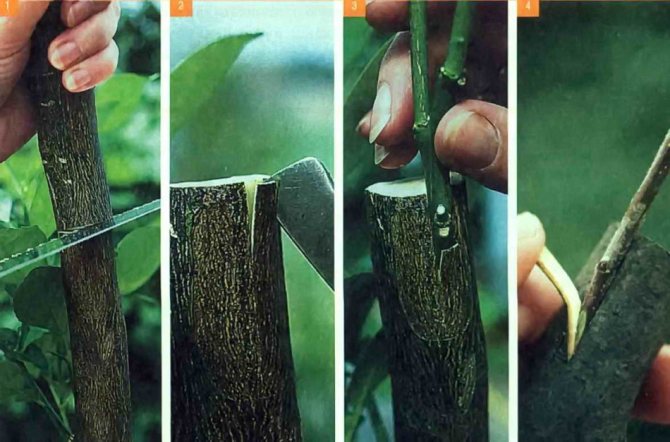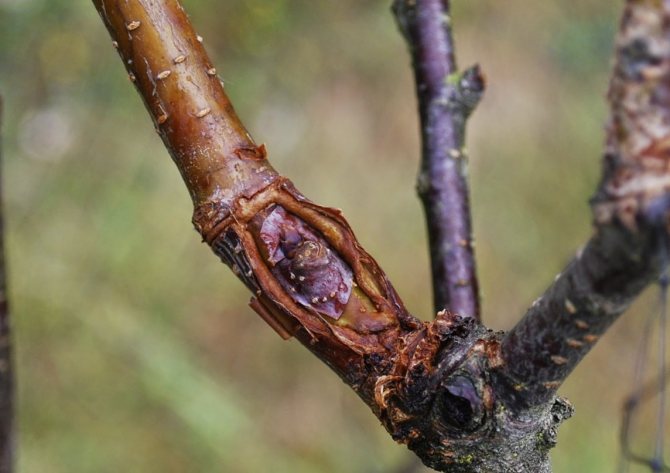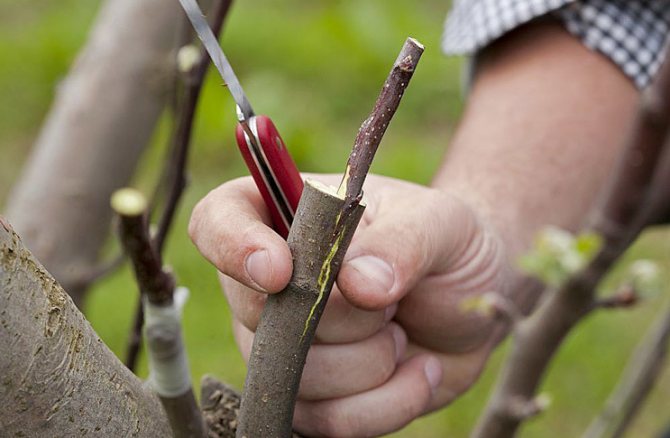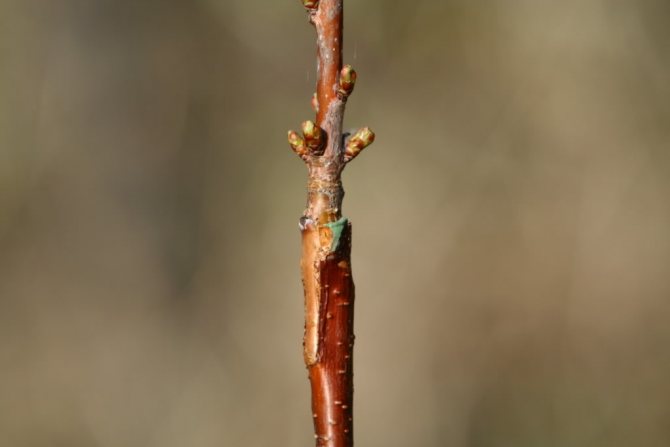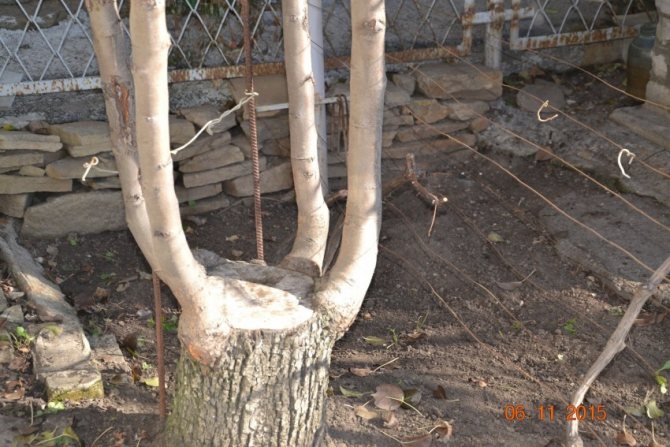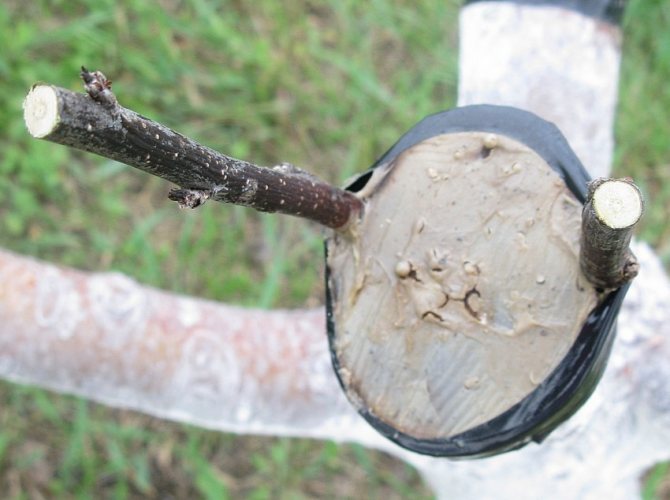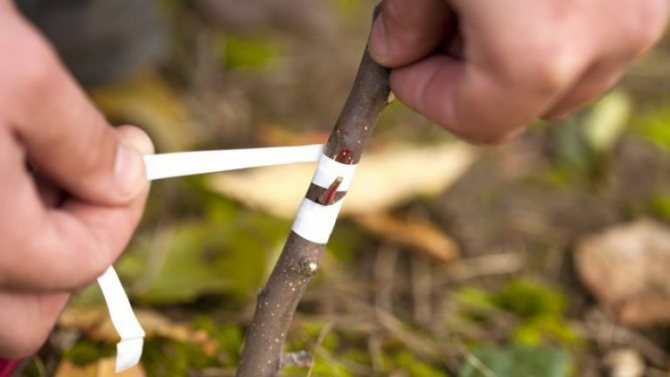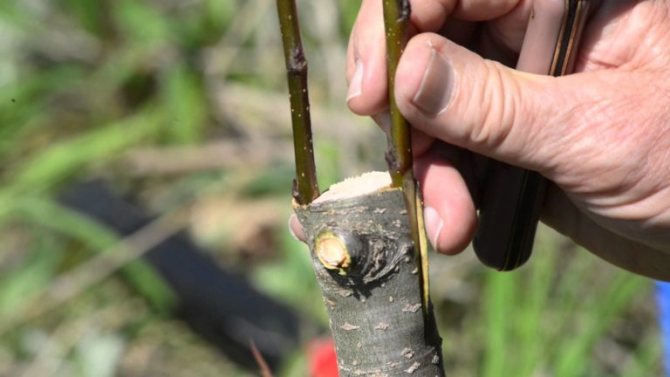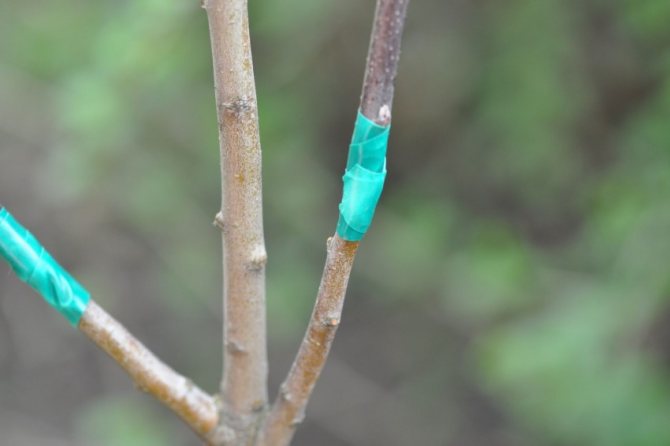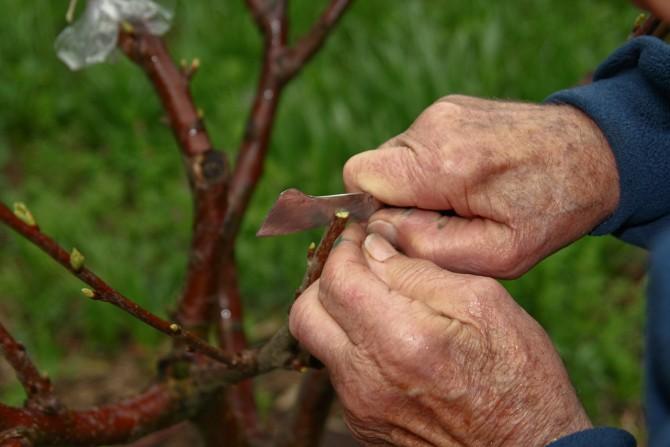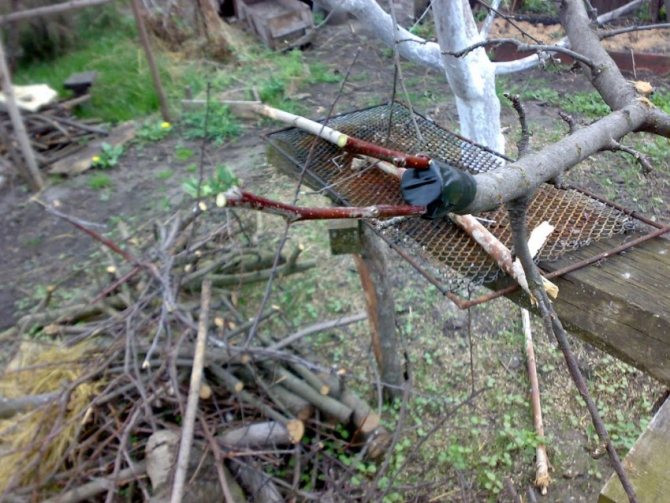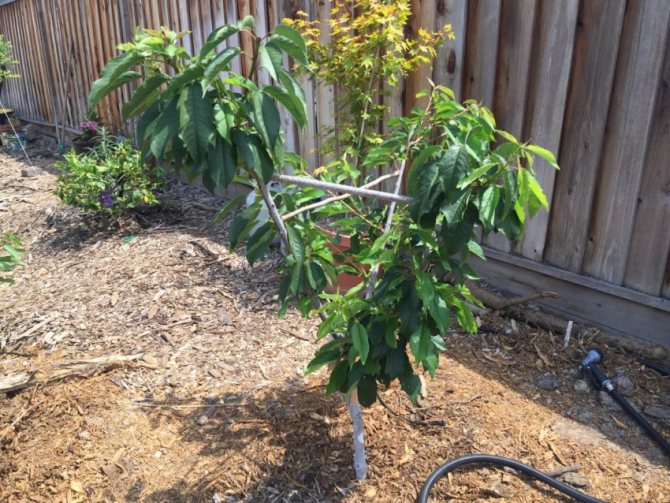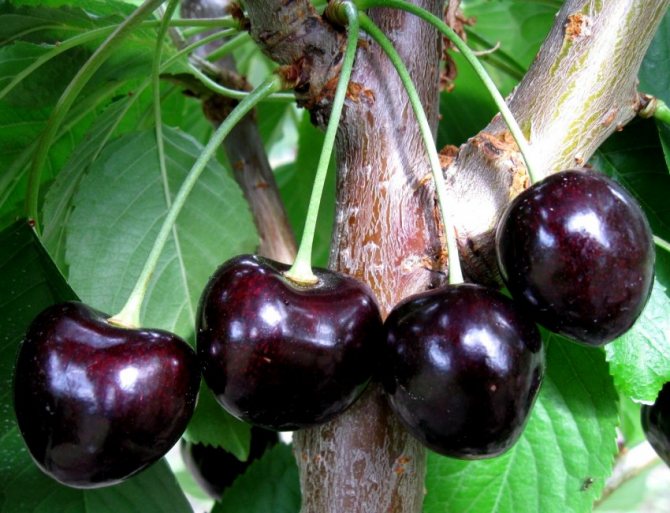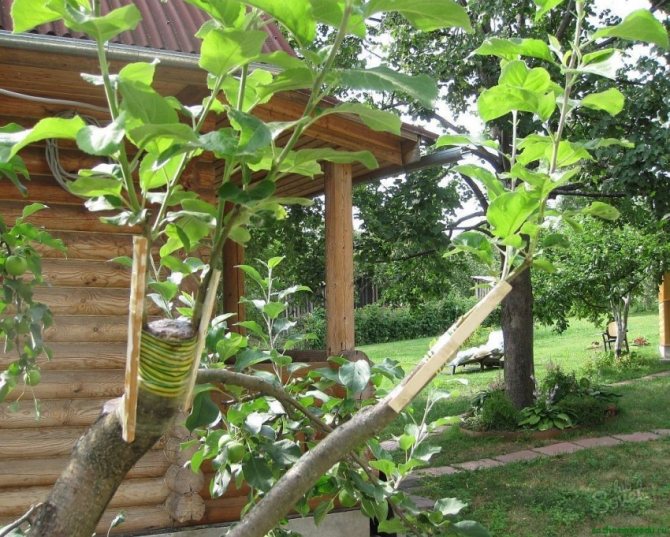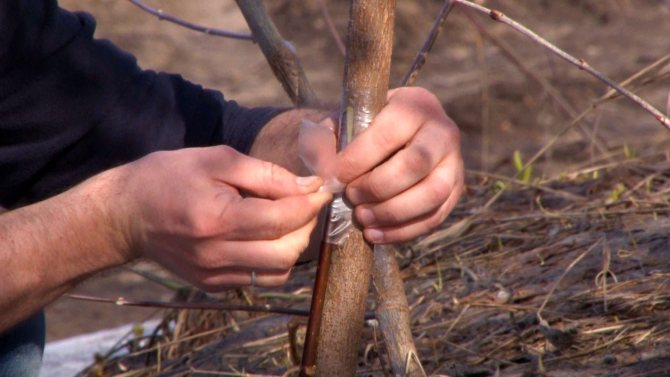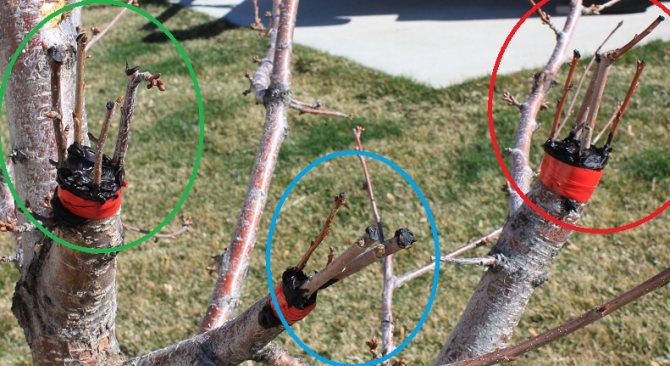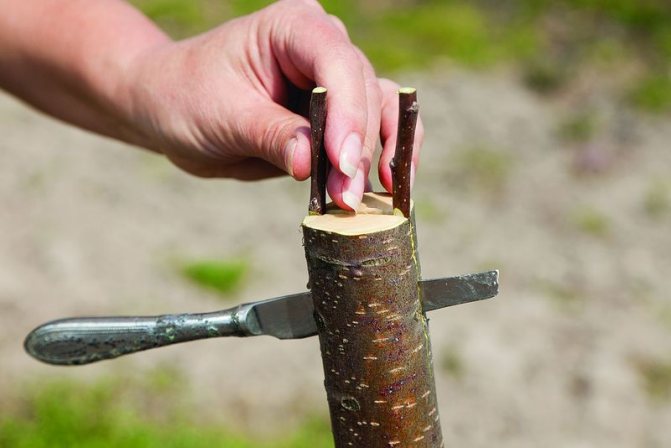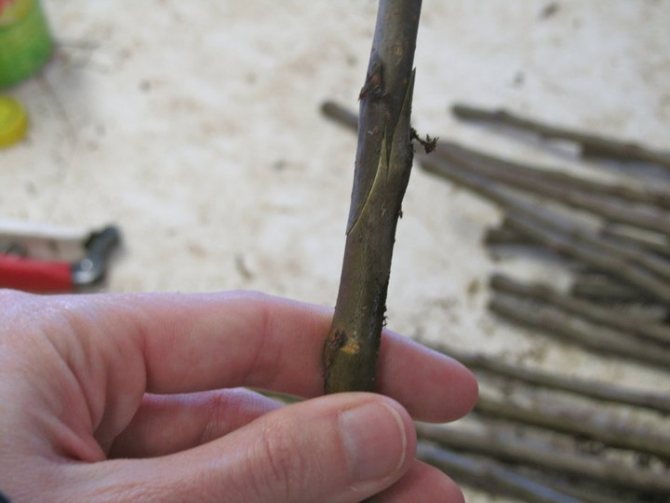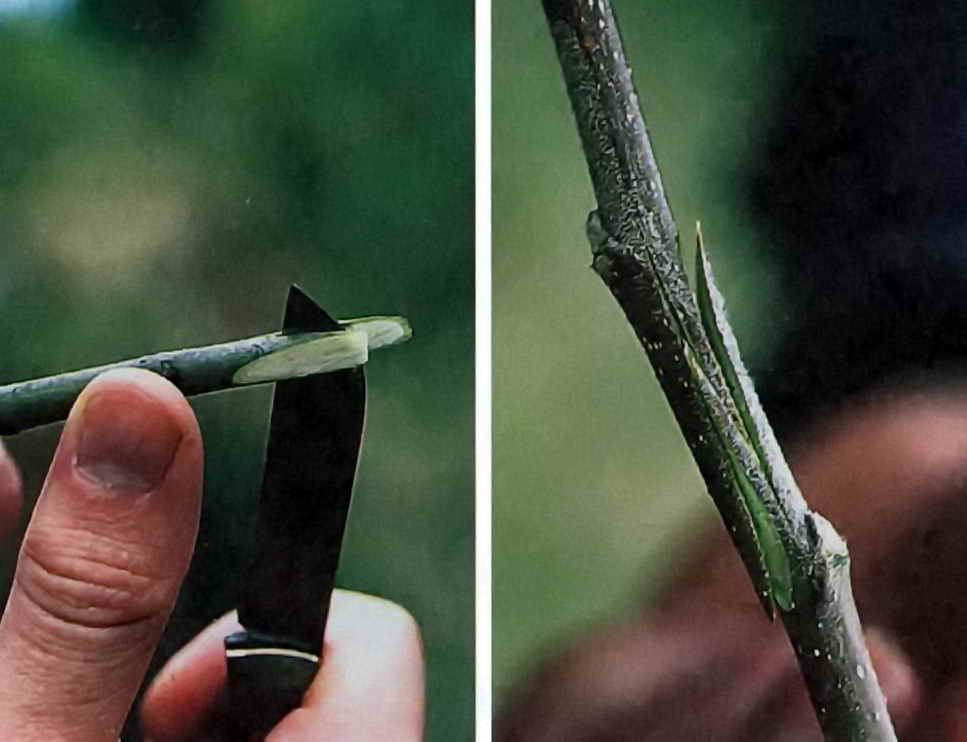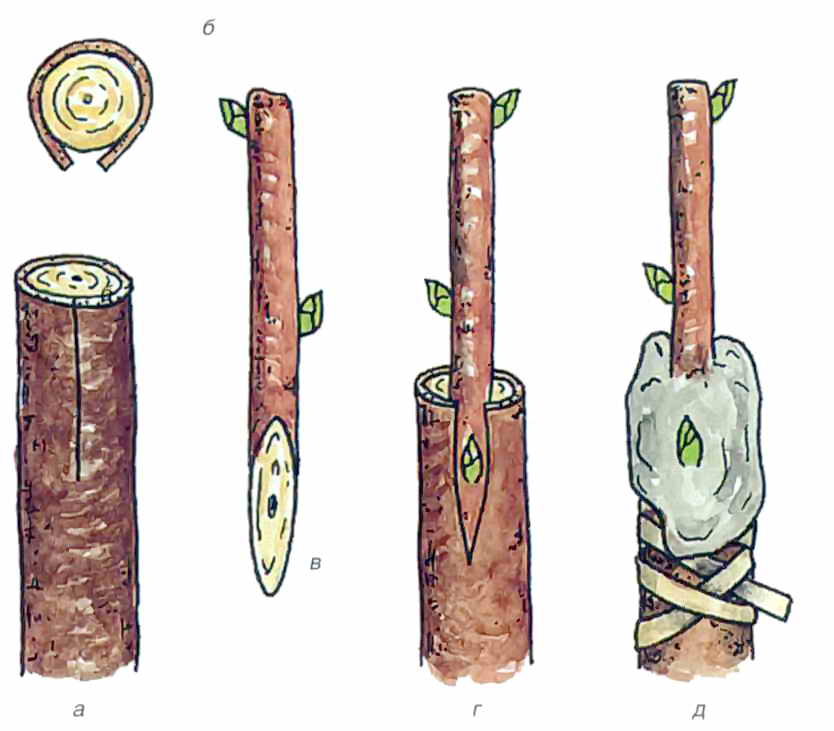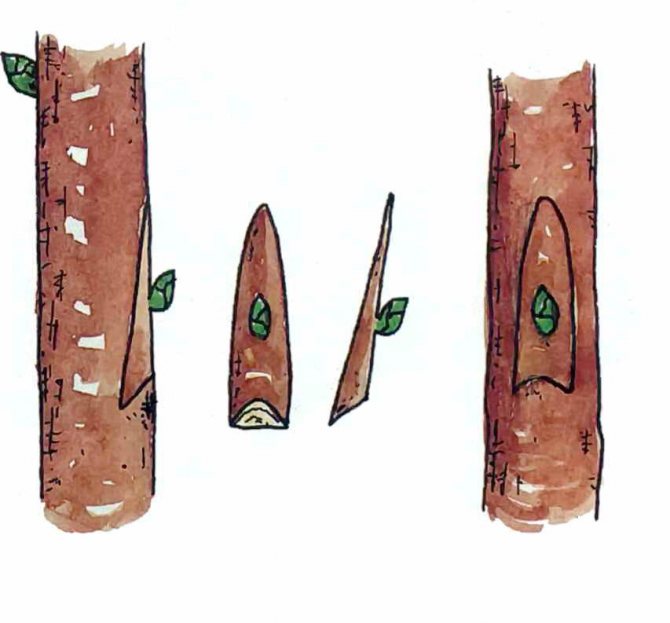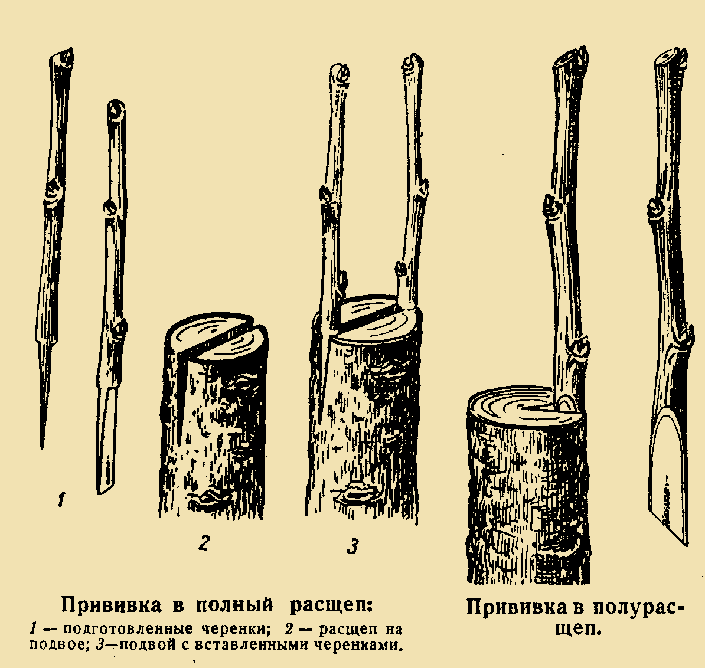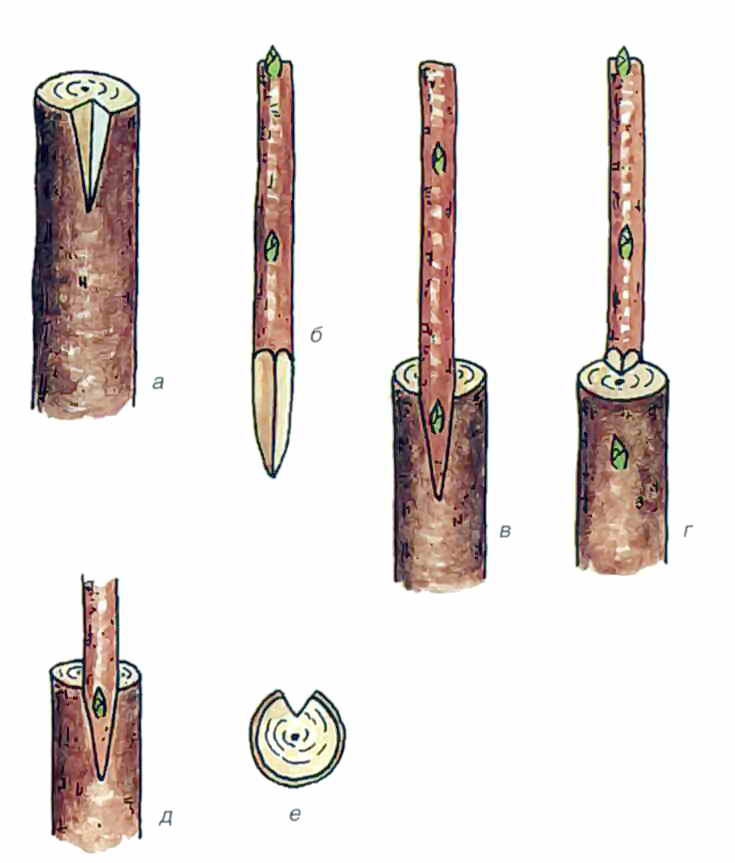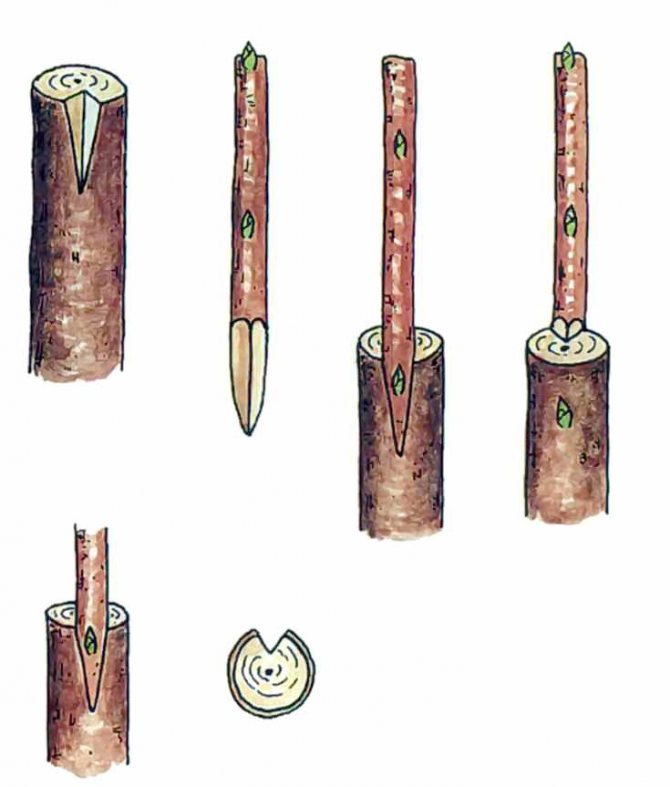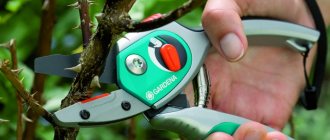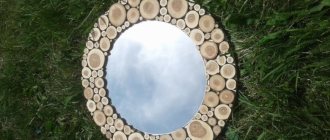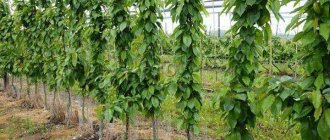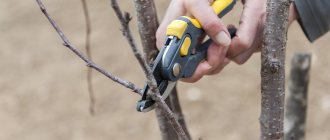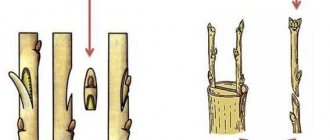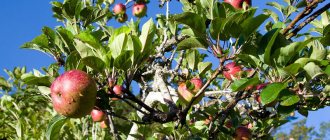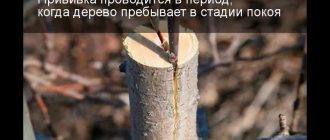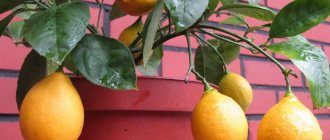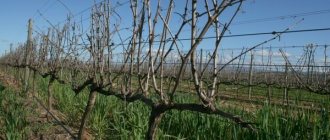Why plant cherries?
Of course, grafting any tree is an additional hassle and risk. But more often than not, it is thanks to this method that you can get the best fruits. The same applies to cherries. This method of growing trees has several advantages.
- Even if the desired variety prefers certain climatic conditions, grafting it to another tree can achieve high-quality growth and a bountiful harvest anywhere in the world. Thus, it is easier for the plant to adapt to different environmental conditions.
- As a rule, grafted plants give more yield.
- By grafting different varieties of cherries to each other or to other types of trees, an entirely new variety of fruit can be produced, possibly much better alternatives available.
What is tree grafting and why is it needed?
Grafting a tree is, in essence, propagating and improving the quality of a plant by replanting a cutting. The shoot of the tree, which needs to be preserved, is transplanted to a "strong" plant. In this case, after fusion, the characteristics of the cutting will prevail.
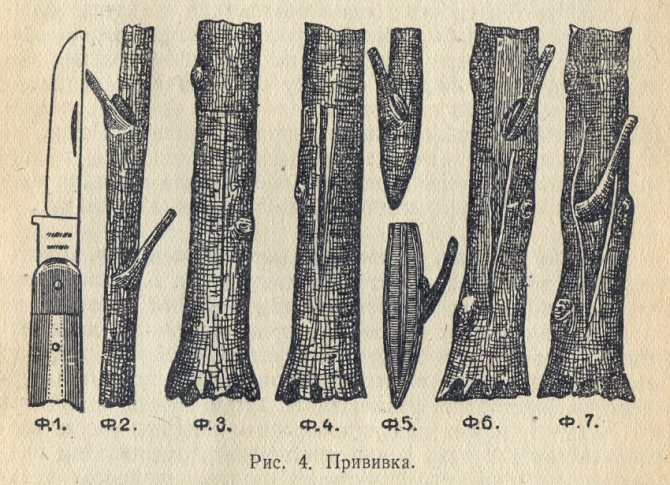
There are many reasons for such a procedure. For example, there is a favorite cherry variety in the garden, but the tree is old, it is hard to tolerate the climate, has ceased to bear fruit, the taste of berries (fruits) has become worse.
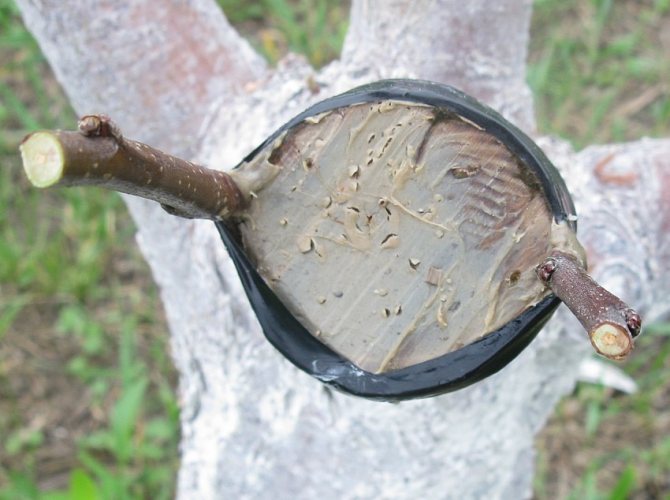

Another challenge that grafting will help to cope with is turning a non-varietal fruit tree into a plant that meets the needs of any gardener. There is no need to saw or uproot the tree.
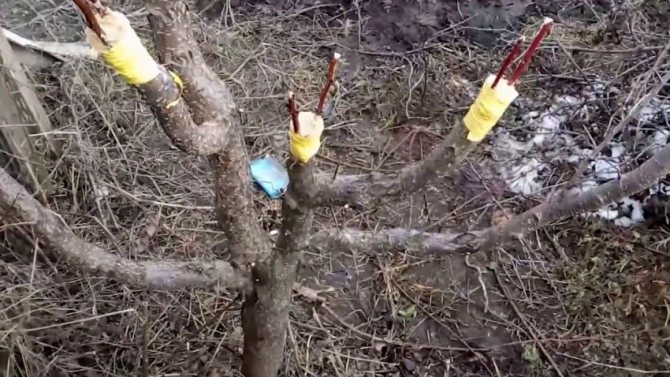

What trees can be grafted with cherries?
Not every tree can take root cherries, although amateurs experiment a lot with different species. And yet there are several proven and reliable options for which you can graft cherries without much risk.
- The first option, and the easiest one, is to graft cherries onto another variety of cherries. At the same time, the main tree (rootstock) must be strong, resistant to any climate, temperature, as well as pests and diseases. In this case, you can get the maximum yield. The resulting tree, after a few years, will be strong, persistent, rich in harvest almost every year. If the base tree is capricious, then there will be little harvest even after a few years on the grafted tree.
- The most popular option is grafting cherries onto cherries. This method has many advantages. It is on cherries that cherries quickly take root. But, in addition, every year from one tree it will be possible to collect two types of berries.
- Cherry plum is also a common option. Not only cherries, but also cherries, apricots can easily get along with it. It has strong branches, much stronger than the same cherry or cherry, so you don't have to worry about the tree breaking under the weight of the fruit. Sometimes even supports are not required. And the stalk grows together with it without problems.
- Plum is rarely chosen as a neighbor for cherries. But experienced gardeners love to experiment in this way. Cherry takes a long time to take root on the plum, but if you show patience, you can get an unusual combination. Such a tree will surprise all friends and neighbors!
Which season to choose for vaccination
Sweet cherries are grafted during the growing season. But the best period for grafting all fruit trees is spring. It is important that there are no frosts at this time.Cherries are grafted in spring with prepared stalks. They were taken out of the cellar in advance, saturated with moisture and root. In the spring, all methods of splicing the scion and rootstock are used:
- budding;
- copulation:
- grafting for the bark;
- lateral incision grafting;
- cleft inoculation.
Sometimes an experienced gardener uses ablation - two young cherries are grafted into the trunk. After fusion, an inch is taken from one tree, and a root is taken from another.
Early June is still a good time to graft cherries on cherries in the summer. It is important to saturate the soil under the mother tree with moisture in the summer before vaccination. Water the plant regularly for 3 days. The cuttings are also kept in water with a stimulant at this time. Most often in the summer, cherries are implanted by means of budding, with an eye.
In the summer, it is possible to carry out inoculations in the cleft and behind the bark. It is important to prepare cuttings about 1 cm in diameter for better survival. Cherries are a good graft. The established stalk feels good. But after a few years, the sweet cherry becomes noticeably thicker at the junction. She has a strong sap flow. To prevent this from happening, so that the branches do not break off under the weight of the crop, it is necessary to furrow the junction. How to plant cherries on cherries depends on the condition of the scion and rootstock.
With a partial scion, the tree can bestow cherries and cherries. Cherry varieties serve as a good stock:
- Megaleb cherry has high winter hardiness;
- Pica - excellent scion compatibility;
- VSL - goes well with any varieties of cherries;
- Vladimirskaya cherry - high winter hardiness, good survival rate of the scion.
If there is an old cherry tree in the garden that no longer bears fruit, but has long adapted to frost, this is an excellent rootstock for new cherry cuttings. They can be placed along the trunk, on a cut, take different varieties, from this a fruitful tree will become picturesque.
Is it possible to plant cherries on cherries if the tree bears fruit? Inoculation can be carried out into the stem shoot and skeletal branches. This is how the pollinator variety is usually planted if the garden area is small. Grafting can correct the taste, size, yield of the stock.
You can experiment with vaccinations in the fall for a short period. It is necessary for the cutting to start before the frost sets in and the sap flow stops.
How to plant cherries correctly?
The first thing to look out for is the grafting time. Best of all, of course, in spring, when there is an active movement of juices in the tree. It is this period that is recommended for beginners who have not previously planted capricious cherries. But in principle it is possible in another period (summer, September), the main thing is only that the tree has time to take root before the cold weather. Otherwise, next year you will have to start the procedure all over again.
The second is the grafting method. He is chosen after deciding what to graft cherries on. It is best to use the grafting method by cuttings (copulation). It has been tested over the years and by more than one farmer who is satisfied with the final result. Cuttings must be prepared in advance - in late autumn, when the last leaves fall from the tree. It is these cuttings that need to be grafted in the spring. If the grafting takes place in the fall or summer, you should use fresh cuttings. The length of the stalk should be 10-15 cm, with a diameter of 5-7 mm.
It is easier and faster to graft cuttings into the cleft behind the bark. It is this method, otherwise referred to as "with a tongue", should be used by an inexperienced gardener. But you can use other methods: lateral, in the cleft, in the bark. They are also effective, but require the experience of the gardener to know exactly where and how to make cuts, how to tie cuttings, and so on, so that the tree takes root and does not wither.
Care features
The grafted cherries require care. The soil of the tree must be fed and monitored for moisture.
By following the simple rules of grafting cherries, you can significantly improve its resistance to bad weather and diseases, as well as increase the taste of berries.
After the plum shoot has been grafted onto the cherry, the tree must be properly looked after:
- A month after inoculation, the winding is removed, and the established plum stalk is fixed with a bus. This is necessary to prevent the escape from being broken by a strong wind.
- On trees, you need to promptly remove young growth, which takes nutrients from the shoot.
- During the period of active growth, cherries are fed with nitrogen, and in the fall, potash and phosphorus fertilizers are applied.
What do the experts advise?
- When choosing a tree on which a cutting is grafted, you should carefully consider its condition and characteristics. If it is weak, sick or "capricious", then the cutting will either not take root, or the yield will be low.
- During vaccination, it is necessary to make all sections as accurately as possible, the better the cutting becomes in the cut, the faster it will take root. For this, "tongues" are made. They serve as grooves for which the trees are securely held together.
- The trees recommended above are just a small fraction of what cherries can be grafted onto. If there is a desire and opportunity, you can update the sweet cherry by grafting it on any cultivated tree, including an apple tree, a pear and even an apricot. It just may take longer and the vaccination methods will be more difficult.
Varieties, varieties and features of the culture
Cherry belongs to stone fruit crops widespread in Russia. The plant is unpretentious, thanks to this it grows not only at home (in the Crimea and the Caucasus), but also in other regions of Russia.
A certain variety is selected for each region. It has distinctive features associated with yield in certain climatic conditions, soil characteristics and moisture level, winter hardiness, the ability to resist the influence of diseases or resistance to parasites. In addition, there are late or early maturing varieties.
Attention! For almost every region of the country, breeders have developed their own, the most suitable varieties. Trying to grow trees in unsuitable conditions for them is a significant effort without any guarantees for a harvest.


Cherry tree
In the Moscow region and central Russia, it is better to plant frost-resistant varieties. These include Chernokorka, Molodezhnaya, Volochaevka, Malinovka, Vole, etc. Tall Turgenevka (up to 3 m), also common in these regions, yields a harvest in early July, and its berries are large and fleshy. However, the disadvantage of the variety is the period of 5 years required after planting until the first harvest is obtained.
Generous is a sour variety that yields up to 8 kg. from the plant. Frosting is a sweet dessert berry. The tree bears harvest from mid-July. The disadvantages of the variety include poor resistance to spring frosts, which occur after the snow melts. Altai swallow is a special variety bred for Siberia with its harsh climate. Self-pollinated early ripening variety is widespread among gardeners.
Felt (Chinese) cherry is interesting as a species. It differs in growth (up to 3.5 m). Flowers bloom simultaneously with the appearance of leaves, very amicably. They have a pleasant aroma, attracting bees to them. The flowering plant itself resembles a bouquet of flowers. Harvested from one tree up to 4 kg. Small cherries - 2-3 gr. They are notable for poor keeping quality, therefore the variety is not grown on an industrial scale. To the taste, felt cherry is sweet, reminiscent of sweet cherry. This makes it popular with gardeners. The downside is the short life span - no more than 20 years. The variety is most often used in the Far East of Russia in China, since ordinary cherries take root there poorly.
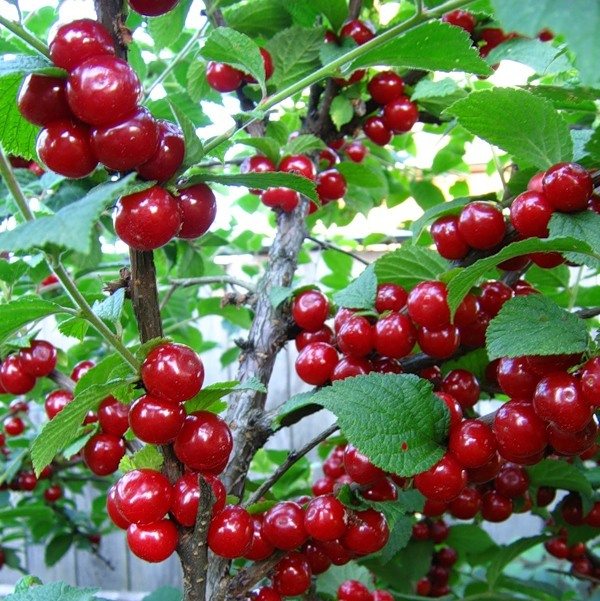

Felt (Chinese) Cherry
Is it possible to plant cherries on plums
Of course, for an inexperienced gardener, the question will arise - is it possible to plant cherries on a plum tree? Is such a vaccination possible and what will be the result? And these are fair questions. The answer will be unequivocally positive: you can plant cherries on plums. And even vice versa. Both of these trees belong to the stone fruit family, that is, they are akin to each other.
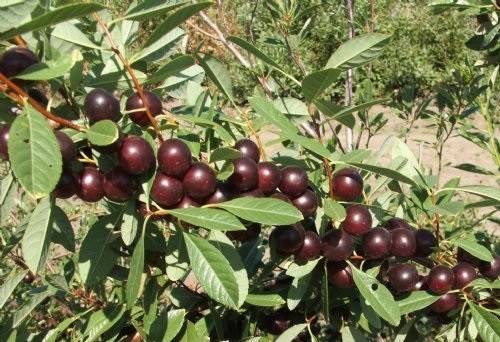

This is what a plum-cherry hybrid looks like.
You can also plant cherries on cherries, cherry plums, bird cherries, and thorns. Cherry plum is also called Russian plum, it tolerates frost well and can give the cherry good qualities. But unfortunately, cuttings of cherries and cherries rarely take root on it. If you want to cross bird cherry and cherry - choose the type Antipka, it is the closest relative of cherry. The blackthorn accepts the scion well, which is not surprising, because this prickly plum is also a fellow cherry.
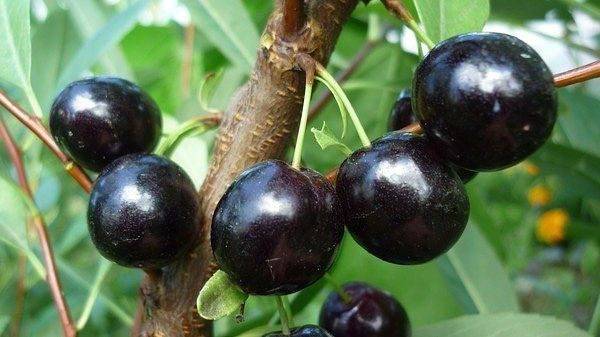

On the outside, the hybrid has a dark mixed color and an average size between plum and cherry.
There are a number of nuances that you should know before carrying out the procedure.
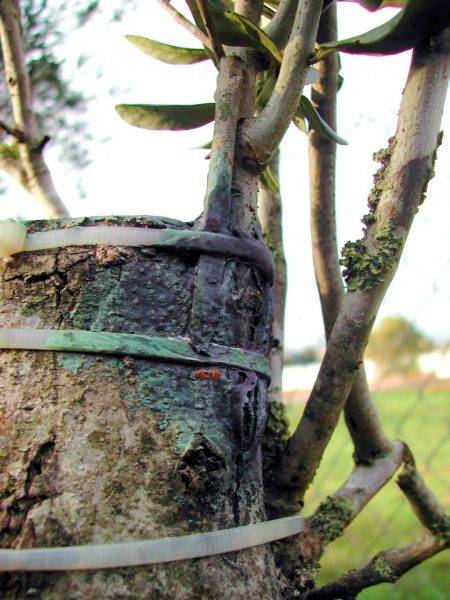

Plants of the same family can be grafted to give new properties to the scion
Video: how to get a good result from vaccination
General information on grafting cherries on plums
It is worth noting, first of all, that the grafting of two plants is carried out to obtain a healthier, stronger (for example, more winter-hardy or more disease-resistant) tree. For example, if you decide to graft part of a cherry to a plum, then the latter should be zoned. Thus, the scion will acquire properties (adapt) to the climate of the region.
Graft - a plant (in this case, a cherry), part of which is grafted onto another plant to obtain new qualities. The stock is the plant to which it is grafted (in this case, the plum).
By the way, in this way (by grafting), you can propagate not only trees, but also small shrubs.
Let's look at the options that can be obtained as a result of crossing:
- new variety;
- a tree with two types of fruits;
- getting an early harvest;
- preservation of the species and variety.
You need to know that the grafted cherry in this case is responsible for the quality of the variety and future berries, and the plum is responsible for adaptability, nutrition and growth.
How does tree parts grow together? Cambium is the fabric that "connects" a cherry stalk and a plum shoot. In the course of inoculation, the graft is applied to the stock in slices on which the cambium is exposed. Tree sap oozes from it, which will help the splicing and formation of new connective tissue.
Cherry grafting - learning to cross with plum, bird cherry? +
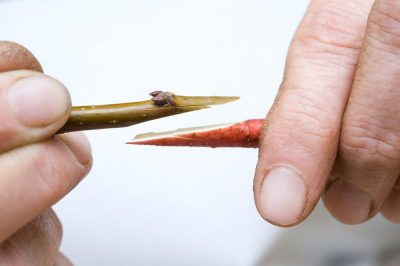

Grafting in horticulture refers to the addition of one plant variety to another to improve fruit quality and breeding. Trees and shrubs of the same species can be spliced, but of different varieties, or different species, but of the same family - it is not forbidden to try. Crossing occurs by transferring some part of one plant to another, as a result of which fusion occurs.
What is it for? The answer is simple - for the birth of a new organism. Everything is like with people: one "parent" is strong and reliable (in our case, the root system), the second is a noble aristocrat (good variety), together they produce strong offspring.
For example, if you plant a tree seedling, you will wait for the fruits from it only after 7-10 years. If fresh shoots are grafted onto an adult bush, the harvest is guaranteed in three years.
Are you attracted by the prospect? In addition, the fruits will be simply amazing both in taste and in external qualities.
Experienced gardeners share their experiences and say that these results can be easily achieved through experiments with grafting.
- Improve the vitality of your favorite tree. It is known that cherry grows poorly in the harsh Siberian cold. But if a southern one is grafted to the local frost-resistant species, you can get a valuable fruit variety.
- It is possible to collect 2-3 flavors of this culture from one fruit tree.
- Quickly get the variety you like from your neighbor. You just need to take a seedling from him and graft it to your tree of the same type.
- You can save even if the tree is in mortal danger. You can even graft to a stump, as long as the root is intact.
Breeder's Basic Rules
We need to be aware that vaccination is a multi-well-known problem. First, the scion is the part that is grafted. It can be a stem, bud or sprout of a varietal plant. It is the scion that is responsible for the variety and quality of the future harvest.
The second - the rootstock - is the "head" plant, the one on which they are grafted. He is responsible for nutrition and fitness. Cambium is the main "connector" that is located between wood and bast. When "splicing" the plants are laid on top of each other with "wounds" - a naked cambium.
He begins to dispense juice from both sides, which splices tissue and forms new ones.
The diameters of the scion and rootstock must be the same for better splicing!
Cherry grafting is divided into spring and summer. But most gardeners choose spring. It is difficult to say unequivocally what month it should be, because we live in different climatic zones. Let the time when the last snow has not melted yet, in some places the earth is already visible, the first thawed patches have appeared, and buds swell on the trees.
It is important to "catch" this moment before the start of sap flow in the tree. In advance, in the fall, take care of the cuttings. As soon as the time for leaf fall has passed, prepare the scion. These should be shoots up to 40 cm long. It is recommended to store them in the basement, buried in sawdust or wet sand. Make sure that the temperature regime is at least 1 ° C. And let them rest until better times.
Vaccination methods
Tree budding is the only method used in August. Cherry propagation occurs by introducing an eye with a bud into an incision under the bark. The junction is well tied up and left for the winter. Applicable only for frost-free areas. Effective for breeding new varieties of cherries.
The method "in the butt with a tongue" for grafting cherries is used in cases where the diameters of the stock and the scion do not coincide (if the stock is thicker). They are connected at the same angle and tied. The bandage is removed after complete fusion. When crossing for the bark, the opposite is true. If the seedlings (scion) are thicker in comparison with the diameter of the main plant, then the bark is incised about 3 cm and the scion is inserted into the incision and tied.
Improved copulation - the method is very popular when the scion and rootstock are well matched and have the same thickness. Cut a little, apply to each other and, again, bandage well. The splitting method is used if the seedling has small shoots, but their diameter is larger than the rootstock.
In this case, the lower part of the cutting is cut in the form of a sharp wedge, about 10 cm is cut in the middle of the rootstock and a cherry seedling is introduced, after which it is tightly tied. It's hard for yourself to imagine all this just after reading the text, so we took care of the video materials, so take the time to watch it.
Despite the variety of vaccination options, there are general rules that will help you achieve results. Experts in the field of selection of fruit plants recommend giving priority to the stock. He must be healthy and strong.
For example, if you like a wild shrub, transfer it to your garden. Do not touch it for 2-3 years, let it take root well. Only then will he become a good donor. The same recommendations will be in the event that the tree looked after for grafting in the garden does not grow where you want.
Transplant it and give it a survival time of at least 1 year!
What are we going to cross cherries with?
And now we need to decide what we are going to graft cherries for? In order to ensure the purity of the experience, it is important to know that there is also a relationship in nature, which is important to observe when crossing. Again, like with people - take a half from a kind-tribe. So, allowed:
- intraspecific crosses (for varietal species - wild cherry);
- interspecific (cherry to sweet cherry);
- intergeneric vaccinations (cherries on plums).
Let's consider the last option. Plum is considered the most suitable stone fruit stock. If you decide to graft it to a cherry, then it is better to take a semi-wild plum, it adapts well and has a high resistance to disease. We're talking about finding a new cherry home. Here, undersized trees with bluish fruits are the best option. In addition, the result will look unusual.
The most common crossing option, favorite among gardeners, is the grafting of several varieties of sweet cherry on one cherry tree. It is interesting that the fruits will ripen at the times characteristic of a particular type of grafted plant. This means that you can get a harvest of cherries from one bush several times per season. In addition, you do not have to worry about pollination, there is a pollinator variety among the scion.
IT'S INTERESTING: How to fertilize parsley
Advantages and disadvantages of grafting cherries on plums
Of course, there are more advantages than disadvantages. Otherwise, there would be no such experiments, already at the beginning stage people would understand the meaninglessness of action. However, grafting of cherries on plums is very common.
The advantages of this crossing:
- The taste is extraordinary: the aroma and juiciness of cherries interspersed with the sweetness and tenderness of plums;
- Improved properties of cherries grafted onto zoned plums;
- The ability to preserve a variety or species, which for the most part (except for cuttings) dies, dries up, does not take root, etc.
- An early harvest of an unusually tasty and unusual berry. You will get a harvest much earlier than when planting a cherry seedling in the ground.
Of the shortcomings, only the complexity of the procedure and a high percentage of cuttings not taking root can be distinguished. And in the future, of course, such a tree requires a lot of care and self-care.
Care involves careful treatment from harmful insects: aphids, cherry sawfly, moths, etc. And also from diseases inherent in both cherries and plums, because now you have a hybrid. Plus, don't forget about fertilizing and pruning.
It is worth observing the tree, as it may surprise you a lot with its new properties. Whether it will be tall, spreading, branchy depends on the acquired properties from the plum. And, of course, the cherry character also contributes. All this together will be reflected in the new variety. How to handle it, most likely, you will understand in the process. The peculiarities of the tree will create your unique care system.
The experiences of amateur gardeners and seasoned breeders help us understand what the pros and cons of a vaccination technique can be.
Video: bought one seedling - planted two!
Further care
In the first year after vaccination, carry out preventive treatment of the tree from pests. Experienced gardeners advise using Biotlin or Tanrek products. Branches growing near the grafting site should be removed - such stems take away plant juices and prevent the cuttings from taking root. If the procedure was carried out in the spring, at the end of summer, the tops should be pinched.
Important! Do not forget about the standard varietal standards for plum care. With proper watering and feeding, grafting of cherries shows the best survival rate.
Sweet cherries will successfully take root on the plum, if you meet the deadlines and choose the appropriate method for the procedure. Considering all these subtleties, the gardener will successfully cope with the task and after a while will receive a rich harvest of sweet cherries.
Best time to get vaccinated
Mostly they do spring or summer vaccinations.Although recently, surprisingly, it is a fact that cultivars began to practice winter. It is difficult to say how effective it is or not, since there are still few reliable results.
But for a long time, breeders have mainly used the grafting technique in the spring. How do you catch the best time for your procedure? The most important thing is not to miss the sap water. Pay attention, it begins even when the snow has thawed, but the earth has already appeared, and the buds on the trees and shrubs have noticeably swollen.
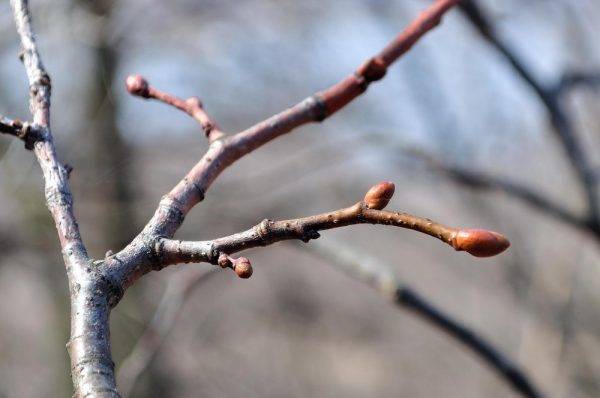

The first thawed patches appeared, and the buds on the trees swelled - you can vaccinate
What tools should you use?
In the process of preparing for grafting, as well as during the sitting itself, only sharp, clean and disinfected instruments should be used. This is necessary in order to avoid disease and plant decay.
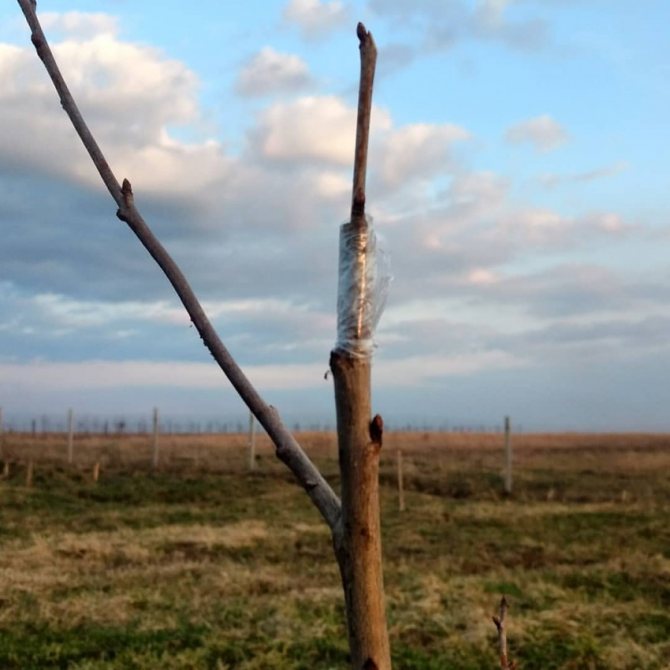

Which tools to use depends mainly on the type of wood chips. To work you will need:
- garden knife;
- sector;
- grafting knife;
- eyepiece knife.
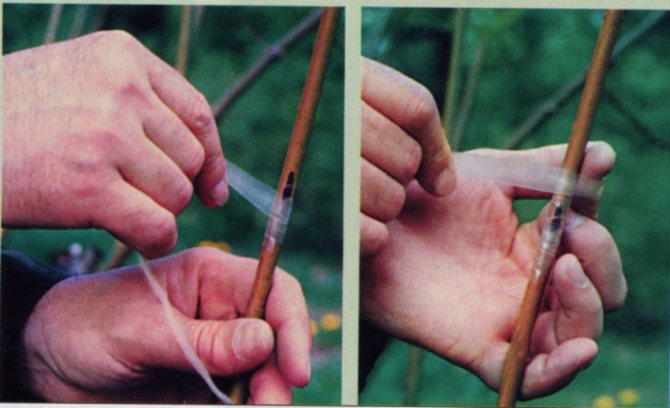

Ways of grafting cherries on plums
It is important to remember that all vaccination methods are more effective in springtime.
Experienced gardeners can carry out the procedure in the butt (that is, by applying the scion to the incision on the side of the plum, or behind the bark).
For the bark
There should be about 5 buds on the rootstock, and the length of the scion cuttings is about 25–30 cm, ideally no more than 4 cm in diameter. The rootstock shoot should not be rough, damaged or with outgrowths. On the drain, make a neat incision on the side (as if cutting the bark a little inward). In this incision, you must extremely carefully insert the handle with a notch. On cherries, a lateral incision is made so that later the tissues of both trees easily touch at the incisions. This is a rather difficult method as it requires a firm hand and knowledge, therefore it is mainly suitable for experienced gardeners.
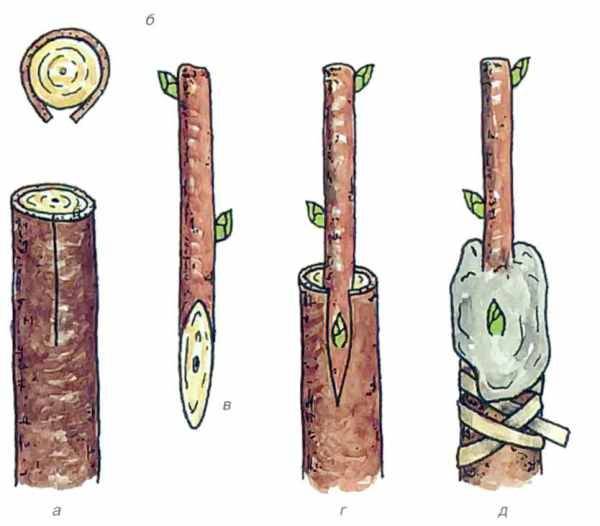

An example of how to graft plants by the bark
This method is ideal for use in early spring at the beginning of sap flow in trees.
Video: how to properly vaccinate the bark in the spring
Budding and copulating
After each procedure, regardless of the method of inoculation, it is necessary to process the injection sites with garden pitch, as well as in the places where the scion is fastened or inserted, fixed with a cloth or tape.
Video: practical budding in the garden
Cleavage grafting
Perhaps this is one of the most common techniques used by gardeners, both experienced and not so. Splitting involves making a vertical notch in the stem of the plum tree where the cherry stalk is placed.
Basic rules of vaccination
The plant that has roots in the ground is called a stock. The part that is implanted by any means into the mother tree is called a scion. For plants to connect, you need to select related crops, such pairs are called compatible. Stone fruits are compatible for grafting cherries. Plum, cherry and apricot are more suitable than others.
The scion and stock take root best during sap flow at an ambient temperature above 5 degrees. Petioles are harvested in the fall. If the winter was warm, the rods for the scion are cut in the spring. Green twigs take root badly.
There are different ways of combining the tissues of two trees, gardeners use one or another method of grafting sweet cherries, like other fruit trees.
Vaccination is a complex operation. In order not to spoil the stock, it is necessary to master the vaccination, fill your hand with waste material. The tool should be hand-tight and sharpened. By combining two even cuts, their connection is achieved.
Grafting technique step by step
Let's look at the instructions for the cleft vaccination. What is the advantage of this method? First, it's a pretty straightforward way. Secondly, it gives a high percentage of cherry accretion on the plum.
Step-by-step instructions for cleavage vaccination
Getting an improved cherry with the qualities of a rootstock is the result of a competent algorithm of actions.
- Grow a young plum as a rootstock. The best age for the procedure is 1–2 years, the trunk of the tree is about 6–8 cm. It may not be a specially grown plum, but quite a living and blooming young sapling, which was planted a year or two ago and feels great. Remember, grafting is not carried out on a diseased tree!
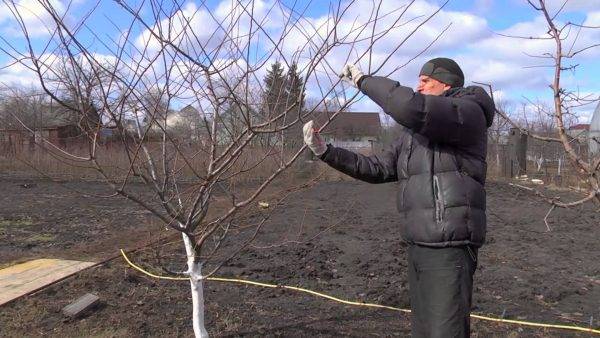

Grafting is carried out only on a healthy tree, preferably no more than 2 years old. - It is best to vaccinate in the spring. Why? Sap flow begins in trees, it is at this moment that the survival rate of the scion gives high results. The juices easily pass into the cuttings planted in the cleft and feed it like a native shoot. The tissues of the trees adjoin well and grow together. Important! Cuttings for spring grafting must be prepared in the fall! Cut branches with two or three buds about 10 cm long from the cherry. Before the procedure, after winter, carefully renew the incisions. Cherry cuttings are prepared in advance - in the fall
- There is also a summer vaccination. You should not try to plant scion cuttings at the end of summer, since the tissues and plums and cherries have already changed, they have become more fibrous. The engraftment, most likely, will not take place. In the middle of summer, you can still graft, the main thing is to do it with green fresh cuttings. Do not make too tight cuts, as vaccination in the summer is already difficult. In general, grafting with fresh cuttings is considered to give fewer results. Mainly due to the fact that in the flowering stage, the cutting cannot simultaneously nourish the shoots and repair wounds. Summer grafting involves green scion cuttings
- Inoculation in the split is also carried out with green fresh cuttings in summer and in autumn in early spring. The main thing is to follow the directions. Prepare scotch tape (tape, cheesecloth or cloth) and garden pitch in advance. If the central trunk is chosen as a stock, retreat from the ground about 30 cm. If a lateral shoot is chosen, then the distance from the trunk is about 20-25 cm. Splitting is a more win-win and less complicated method of grafting
- Splitting should be done on a branch of the stock with a diameter of about 5–7 cm. A deep incision (10–12 cm) is made in the middle with a sharp knife or a small hatchet. The drain manipulation is complete. The cut of the rootstock branch must be clean and neat, as well as the split in it.
- Take your pre-cooked cherry cuttings and cut a couple of side cuts of the wood. You get a kind of wedge. The slices should be as long as the plum splitting depth. Two slices should be made on one side so that the stalk becomes wedge-shaped.
- Insert the graft into the split so that the layers (texture) of the wood match. If your stock is several times thicker than the scion, place two or three cuttings in the cut. Carefully place the cutting in the split so that the cambial layers of the wood coincide and grow together.
- After carefully placing the cuttings in the rootstock, tie the plum with tape or strong cloth along the length of the split. And the places where the scion was placed and the incision was made - cover with garden varnish. Tying the incision sites and treating with garden varnish is important, since this will help the excess juice not to leak out, and the tissues to take root faster
So that the split does not close while you are making side cuts on the cuttings - leave a hatchet in it or put a screwdriver, a strong stick, etc. It is advisable not to remove the object until you make sure that the handle is placed securely and correctly.
Video: cleavage grafting technology from an experienced gardener
Procedure options
Having decided on which stock will be used for grafting next season, in November, when all the leaves fly from the trees, cuttings are harvested. To do this, cut off annual shoots having a diameter of at least 50 mm with one growth bud and several lateral buds.
The branches prepared for grafting are taken to the cellar, where they are placed in the soil of sand, peat, sawdust. If there is no basement, the cuttings are wrapped in a wet cloth, then in polyethylene and stored in the refrigerator.
Cherries are grafted with young green branches from summer to autumn, sometimes such shoots are used in spring, but not always successfully.
Simple copulation
Even novice gardeners can master a method in which the stock has the same diameter as the grafted shoot. On the cherry, a smooth branch is chosen, wiped with a damp cloth. With a sharp knife, an even cut is made on it at an inclination of 35 degrees.
The stalk is prepared from a fertile stone fruit variety with 2 or 4 strong buds, stepping back 10 mm from the lowest one, perform the same operation as on the rootstock. At a distance of 2 cm above the third kidney, another cut is made, but even.
In order for the shoots to grow together correctly, you only need to use a sharp knife during work, otherwise their cambium will not match. The stalk is carefully connected to the stock to form a straight and even branch.
With a strip cut out of polyethylene 1 cm wide, overlap the grafting site, making sure that the cuttings do not move 1 mm, otherwise they will not be able to grow together. The upper cut on the cherry is covered with pitch. This is done in order to prevent the bud of the cutting from dying.
Improved copulation
In order for the shoot to take root sooner, the procedure must be performed very quickly, otherwise the tree on the cut will dry out. Gardeners who have been grafting stone fruit crops for a long time are resorting to improved copulation. They split the places of cuts in the center into a third both on the rootstock and on the cuttings. The resulting tongues contribute to a tighter connection of both grafted parts.
Zakorkovy way
Gardeners cut the upper part of the stock with a pruner; this is done if it is much thicker than the harvested cutting. At the beginning of the growing season, the wood is easily removed from the bark with a sharp knife, and the knots are chopped off with a saw. After that, longitudinal cuts about 4 cm long are made on the stock and cover them with polyethylene.
The stalk is applied to the puncture on the trunk of the plant and wrapped with tape or tape. The cut on the cherry is treated with a special pitch.
Many gardeners use this particular method of grafting, since several shoots are engrafted on one stock, at least one of them still takes root, the plant is less injured.
Into the cleft
In early spring, when the buds have not yet blossomed, stone fruit crops have not woken up from hibernation, they resort to a more complex technology that allows grafting cherries:
- On a tree used as a stock, branches are cut, leaving only a few pieces at the bottom, the trunk is shortened to a height of 50 cm.
- Splits are made in the stump with a small ax and a prepared scion is inserted into each of the stumps, the bottom of which is sharpened like a wedge, tying it to the plant with a ribbon.
- Slices, the thickness of which should not exceed 50 mm, are covered with garden pitch.
This method helps to renew old trees while preserving the cherry variety. Only thin branches are planted. It is better to resort to the procedure in March, in early April.
Semi-cleavage
With this technology, the cherry is almost not damaged, a small part is affected on the side. For grafting the cutting:
- The ax blade is inserted into the stump 30 mm deep, without reaching the opposite end, splitting is performed.
- The lower edge of the shoot is cut off so that it looks like a wedge.
- Wrap with 3 layers of polyethylene.
The graft is tied up with twine. With this method, even a garden pitch is not needed.
Bridge grafting
It happens that in winter hares in search of food get to the garden and gnaw on the bark. To close the wounds in the trunk and renew the cherries, they resort to the technology of grafting with a bridge. It is best to do this when the juice starts to flow.
Recommendations
Experts say that in the entire vaccination procedure, most of your attention and care should be given to the stock, that is, the plum.Choose a tree that is healthy and strong with a good root system and immunity to common diseases. For example, it can even be a wild plum.
Often, it is wild trees and shrubs that have excellent properties that are so difficult to achieve from domesticated counterparts bred in captivity.
For two or three years, transplant the "wild" to your site. When the tree finally takes root and takes root, it will serve as an excellent donor for a new variety.
In grafting cherries on plums (and in general any fruit trees), it is important to properly harvest the scion cuttings.
Video: harvesting cuttings according to the rules
In conclusion, it should be noted that plum is one of the best rootstocks for cherries. Despite the fact that the procedure itself may seem complicated, scrupulous, requiring skill, skills and certain knowledge - you need to try to do it! It is practice that gives experience, as well as the wonderful fruits of hybrids. The state register would not have known so many new varieties if it were not for the curiosity and resourcefulness of scientists. Inoculation of cherries on plums takes pride of place in experimental breeding, as it is very effective.
26 years old, blogger, farmer, young mom, illustrator, graphic designer, freelance correspondent. Higher education in the humanities. I live in Siberia, Ulan-Ude, Republic of Buryatia. Extensive experience in growing garden crops. Rate the article:
(4 votes, average: 2.5 out of 5)
Correct grafting of cherries on plums: which method is more reliable? Why plant cherries on plums and what results to expect?
When our fruit trees are noticeably shallower, giving less fruit, or if they lose their former bright taste, you can graft. Vaccination is the process of engraftment of a branch of one fruit tree on another.
Pros of grafting cherries:
- The taste is enhanced;
- Resilience increases;
- There is an exchange of trace elements;
- Fruiting becomes more frequent;
Cherries are grafted, like most fruit trees, in spring or early summer. It is more comfortable to carry out spring grafting because of the greater margin of time that we have further. In summer, cherry cuttings only have time to take root when frosts are coming. For warm regions, you can carry out and autumn engraftment - the main thing is that the rootstocks and scions are resistant to cold weather.
What can you plant cherries on:
- For cherries of a different type: we improve the basic taste, we get a more resistant variety, no need to replant, familiar care;
- For cherries: close and accessible, similar structures and care features, the variety of fruits increases somewhat, but does not change dramatically;
- Cherry grafting on plums: under the power of advanced gardeners, an amazing result is obtained, hybrid fruiting;
- Cherry plum vaccination: the stock is strong and resistant, can be used as a base for all stone fruits;
For grafting cherries on the plum, cuttings of the grafted tree - in our case, cherries - are cut off in the fall, so that the procedure can be quickly carried out in the spring. With cuttings of the same year, you can graft cherries on plums in the summer. One stalk is 15 cm long and 7 mm thick. Cuttings are dense, whole, healthy, 1-2 years old, from the fruiting part of the tree, with a heel.
Sweet cherry grafting methods: budding, copulation or tongue method, splitting, behind the bark. All 4 methods are effective. Choose the one that suits you. Let's take a quick look at the pros and cons of each.
| Budding | A simple method, a couple of cuts are made. | With an increase in the thickness of the cutting, it is inconvenient to tie. |
| Copulation | Cuttings of the same diameter can be carried out in any weather, except for a rainy day. | Prepare parts in advance. |
| Into the cleft | The old and proven method, on sawn branches, clean cuts. | Only in the spring before the start of sap flow. |
| For the bark | Disease resistance, many productive branches. | Few skeletal branches, not frost-resistant variety. |
How to plant grafted cherries correctly?
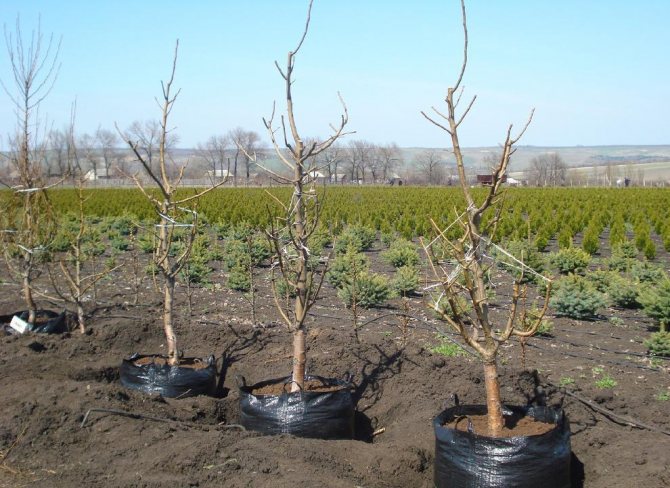

The grafted cherries are transplanted according to the typical scheme.
The grafted cherries are transplanted in the usual manner. For the procedure, it is recommended to choose seedlings, the age of which does not exceed 2-3 years. In this case, you need to take into account some of the nuances. A young tree can be planted in the spring (before the start of sap flow). But preparatory work has been carried out since autumn.
Important! Cherries are dug out of the ground together with an earthen clod and covered with soil so that the bark of the plant is not damaged in winter.
In the fall, a landing pit is also prepared. It is filled with a mixture of equal parts of humus and peat with the addition of 100 g of mineral fertilizer. Next, you need to take into account the following nuances:
- If, before planting, diseased areas are found on the root system, they are removed, and the damaged areas are sprinkled with ash.
- When placing the plant in the planting hole, make sure that the roots do not twist.
- The voids are covered with earth mixed with a nutrient composition, which is prepared from humus and peat (1: 1).
- The root collar should protrude 6–8 cm above the soil, otherwise, after compaction of the soil, the tree will settle, as a result of which the cherry may die.
- The soil is well compacted, and the plant is watered abundantly with water with the addition of Heteroauxin. Five buckets of water require 10 ml of the drug.
- The surface of the soil is covered with a layer of humus or peat.
- In order for the roots to take root better, after transplanting, the branches are shortened by 1/5 of their length.
- The tree is tied to pegs so that the gusts of wind do not damage it.
Transplanting an adult sweet cherry is performed with minor changes. In order for the root system to fit into the hole, the size of the latter must be at least 70x70 cm. Until the tree grows back, it must be watered with 3-4 buckets of water every three days.
The grafting makes it possible to increase the resistance of cherries to unfavorable climatic factors and to improve the taste properties of its fruits. But in order to get the desired result, you need to observe the timing of the procedure and take into account the individual characteristics of the tree.
Hello! Let's get to know each other, my name is Yana Dmitrieva, a foreign economic activity manager by education. Rate the article:
- 5
- 4
- 3
- 2
- 1
(8 votes, average: 4.9 out of 5)
Share with your friends!
How do I process the cut points?
We found out that plant cherries on plums Not only can, but also necessary - this procedure improves fruiting, accelerates the formation of fruits, allows you to get an exceptional harvest. Starting and ending the grafting procedure correctly are essential steps to maintain healthy grafts and rootstocks. It is necessary to process the cuts with garden pitch or activated carbon. A purchased garden pitch is suitable for the procedure, but, alternatively, you can prepare a garden pitch yourself: how to cover the tree after pruning? Cloth / paper is applied over the putty, but not polyethylene, which will create a greenhouse, and then linen or jute, or polyethylene.
↓ Write in the comments how did your vaccination go? Have you chosen a plum as your rootstock, or have you focused on another fruit tree?
Please rate the material you have read :)
Sweet cherry grafting technology
If stone fruit crops grow in a suburban area or in the yard and you want to increase the planting area with fruit trees, you need to take into account that cherries do not reproduce from a stone, but by grafting.
In order for the escape to take root correctly and quickly:
- A healthy stone fruit crop is chosen for the stock, which gives a stable yield.
- A large number of cuttings of different types and ripening periods are not grown on a tree.
- For grafting, strong branches are taken, which are located closer to the trunk.
- The harness is removed after the bark is formed at the junction of the shoot.
In the first year, flowers are plucked on the grafted cherry and the emerging ovary is removed. If this is not done, the tree will grow and develop poorly.Experienced gardeners recommend using cherry and cherry plum as a rootstock, which are well adapted to the local climate. The established stalk after 4 years can be used again for work.
In the spring, any of the methods is suitable for grafting, starting with simple copulation and ending with the most complex technology, you can take pre-prepared shoots and green branches.
To change the variety of cherries, they start grafting. Such a procedure is in demand when the planted plant turned out to be barren, small and tasteless berries ripen on it.
Cherries up to 10 years old are used as a stock. The process is resorted to in the spring, when frosts are no longer expected. Re-vaccination with a kidney or an eye is performed even at the end of summer and is quite effective.
What can you plant cherries on: tree names
Planting fruit trees, regular care, and taking care of the orchard are carried out in order to get a rich harvest of tasty and high-quality fruits. But what is the disappointment when the fruits on the cherries are of unsatisfactory quality. Inexperienced gardeners come up with the idea of uprooting trees and planting new seedlings in their place.
Experienced gardeners, in turn, will not rush to destroy the garden. There are a number of reasons for this:
- It is not a fact that newly planted seedlings will yield a good harvest.
- It will take about 5 years to wait for the first fruiting of young trees.
There is a way that will help to revive cherries, and it will be possible to collect good fruits from a seemingly hopeless tree in 1-3 years. This is the grafting of the tree.
Grafting is a way of vegetative propagation of trees. In simple words, this is the transplantation of a part of a tree from one variety to another. As a result of grafting, two parts of different trees grow together into one, thereby contributing to an improvement in the quality of the fruit.
Vaccination is carried out primarily with the aim of improving the quality of the fruit. There are other benefits of grafting trees as well:
- Increasing frost resistance, which is very important for cherries that are demanding on climatic conditions.
- Improving disease resistance.
- Extending the life of the old garden.
- Reproduction of trees without uprooting.
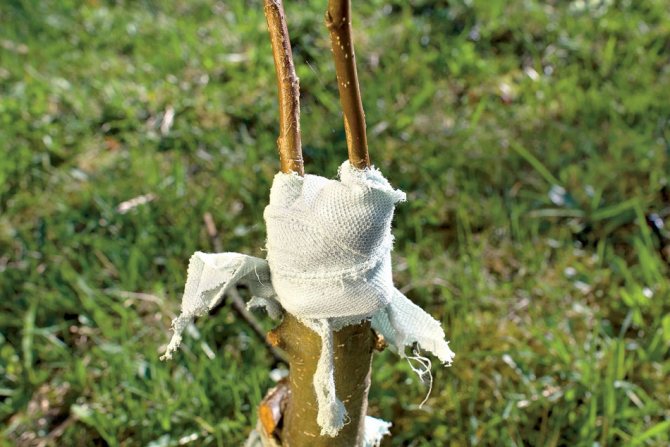

Grafting of trees is done in order to improve the quality of the fruit.
Before planting cherries, you need to decide on a tree for the stock. Sweet cherry is successfully grafted on such trees:
- Sweet cherries for sweet cherries... This grafting is carried out in order to improve the taste of the fruit. If you do not like the taste of cherries, graft a stalk of a tastier and better variety to it. It will be possible to harvest the crop in 1 year.
- Cherry plum... The cherry plum is often grafted with stone fruit trees, including cherries. Such grafting will help make the branches of the sweet cherry stronger, improve the vitality of the sweet cherry in the conditions of closely located groundwater.
- Cherries on cherries... Two related trees take root well with each other. Such a rootstock will make cherries more resistant to the climatic conditions of the region with cold winters.
- Cherry plum... Such experience is within the power of professionals in gardening. If the grafting is successful, you will get an interesting tree, with different types of fruits.
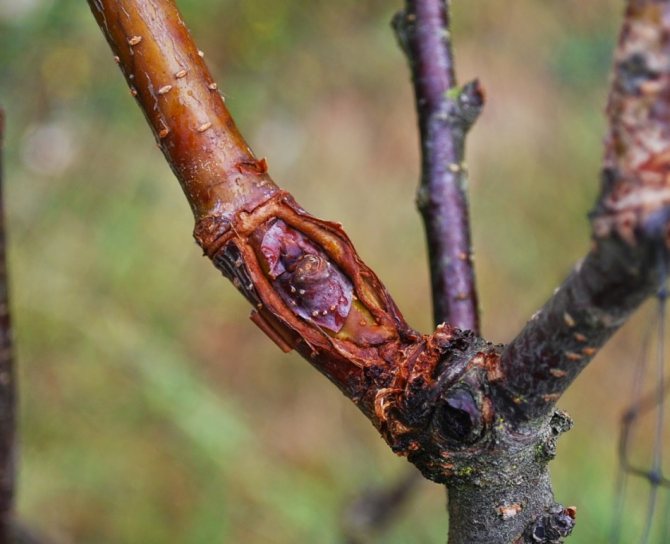

Sweet cherries grafted onto cherries
When are they vaccinated?
Cherry, like every tree, grows old over the years, dries up, and the time comes to replace it. It is a pity for the gardener to part with his favorite berries, and there is nothing to replace it with. In addition, other situations may arise that cause the tree to die off. These are climatic conditions that are not suitable for the cherry, or the tree did not like something in the garden.
Some gardeners are simply looking for another variety, but there are also those who do not lose hope of growing their favorite. In this case, an inoculation will be needed, which will help to eliminate two problems at once: the search for a new seedling and the loss of the variety.
Sweet cherry fruit appearance
In addition, thanks to the successfully carried out manipulation, the gardener will receive berries that are much better in taste, larger and that ripen much faster. In addition, the garden needs to be periodically rejuvenated and old trees removed.
Many people remove the tree in the old fashioned way: they cut down the trunk, dig up the roots and plant a new seedling in their place. In this case, you will have to wait several more years for it to grow and begin to bear fruit. This will take a long time, from five to six years. An experienced gardener will do it differently. He will be vaccinated and get the first crop in two or three years.
What is the best time for grafting cherries: timing
Important: The best time for vaccination is early spring, when active sap flow begins.
- If you decide to plant cherries in early spring, it is important to have time to do this on time, since the favorable period for vaccination is very short, literally 2 weeks. The air temperature at night should not drop below 0 degrees, and the buds should not yet bloom. Spring grafting is preferable for the reason that it is during this period that the probability of growing the cuttings with the stock is highest.
- Also practiced summer vaccination... Provided the procedure is carried out correctly, there is a high probability that the cutting will have time to take root before the onset of frost. The main condition for summer vaccination is cloudy weather, but no rain.
- Autumn grafting of cherries is also practiced, but the likelihood of engraftment of the cuttings is reduced. After all, it is impossible to predict when the frost will begin.
- Grafting of trees is carried out even in winter, but not suitable for cherries. Winter grafting is suitable for trees such as apple, plum, pear.
What is stock and budding
There are two ways to pinch cherries: using a stock or budding. Do not confuse these two concepts, they are completely different processes.
Those who are engaged in gardening know that the tree needs to be grafted in the spring. At this time, sap flow is just beginning, and the vaccine takes root faster. But if you do everything right, then such actions will be successful in the summer and even in the fall.
It is best to vaccinate in March, since it is during this period that the trees wake up and the sap begins to move. There are several ways to vaccinate during this period:
- into cleavage;
- bridge;
- simple copulation;
- for the bark.
For such procedures, you need to stock up on tools such as a knife or pruner. They are necessary in order to be able to make the correct cuts on the scion and rootstock. Only with the correct alignment is a successful result of the operation possible. The fact is that you need to precisely match the green ball of wood under the young bark.
Scions are harvested during the period when the tree is in hibernation; they need to be stored in the cellar. After the buds begin to swell on the rootstock, it is worth vaccinating. The graft, which gets into the heat during vaccination, also begins to revive and draw juice from the rootstock. Circulation of juice begins, due to which all connections are tightened and taken root.
We plant at an angle
In summer and autumn, you can pinch cherries only with the help of budding. For this, a bud is used, which is cut from a tree along with a small piece of wood. The only difference between such a vaccination is that the clothespin will begin to bloom only next year, while the stalk on the rootstock comes to life already this year. But, on the other hand, several buddings can be made on one branch, which will significantly increase the chance of successful engraftment. Also, it should be taken into account that the tree itself receives less injuries, and its branches do not need to be cut off until the graft takes root.
What is the best way to graft cherries?
If you decide to plant trees in your garden, there are two terms to remember:
Rootstock - the tree on which the cutting will be grafted. These should be young trees adapted to the climatic conditions of the region. The best stock is a tree up to 10 years old. On such trees, the processes of accretion are faster.
Graft - a shoot of a tree that will be planted on the stock. Sometimes a branch is grafted, but in most cases a cutting is used - part of a shoot with several buds.
There are many ways to graft trees. Let's consider the most suitable methods for cherries.
Copulation... This method involves combining the cutting with the tree trunk, while both parts must have the same diameter. As a result of attaching the cutting to the trunk, it is as if one whole is obtained. To do this, you need to make oblique cuts on the rootstock and scion, connect the two parts, then wrap tightly with electrical tape. With improved copulation, additional splits are made in the sections, which are then joined.
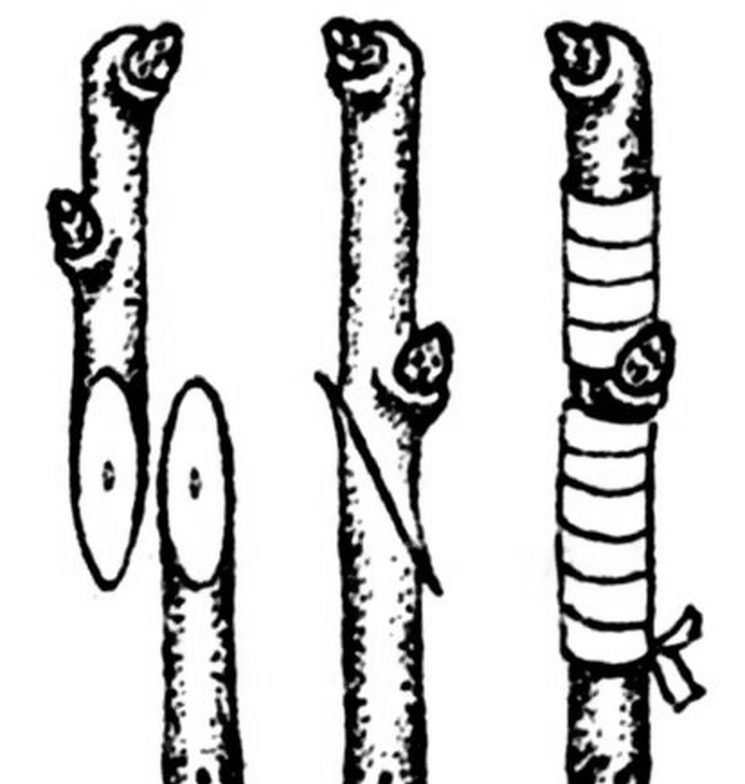

Cherry grafting methods: copulation
Into the cleft... This method is suitable when the diameter of the tree trunk is much larger than the grafted cutting. First, make an even cut on the rootstock. Then a split 4-5 cm deep is made in the center. After that, a cut stalk is inserted into the split. Both parts should fit snugly against each other. The vaccination site is wrapped with electrical tape. Open sections are treated with garden pitch.
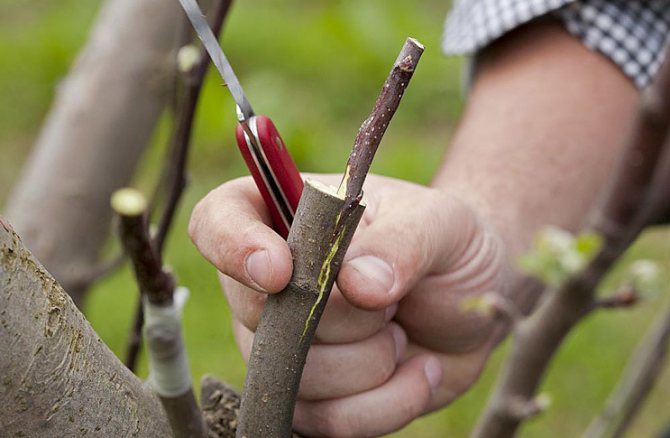

Sweet cherry grafting methods: in the split
For the bark... It is possible to plant trees in a way for the bark when there is a strong sap flow. The essence of this method is that the cutting is inserted into the cut rootstock bark. To do this, make an even clean cut on the rootstock branch, clean it so that there are no unnecessary chipping. Then an incision is made on the bark of a few cm. An oblique cut is made on the handle, gently cleaned from all sides in one motion. Then the stalk is inserted into the bark incision. Several cuttings are grafted onto one branch of the stock from different sides so that the wound grows better.
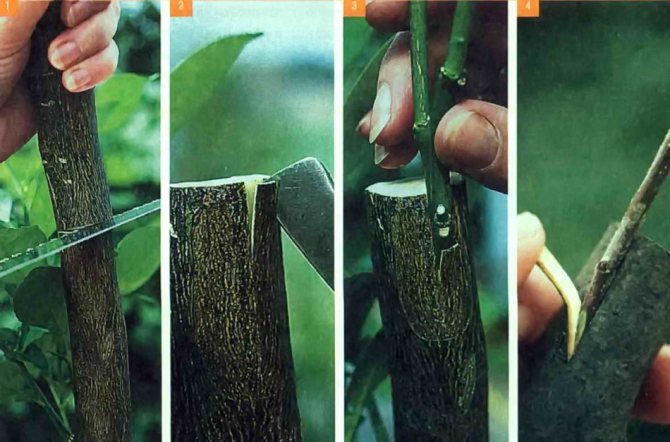

Sweet cherry grafting methods: for the bark
The best way to learn the technique of vaccination is to see it. We suggest watching a video, thanks to which you will learn how to plant cherries correctly.
Cherry grafting: basic rules and plant compatibility
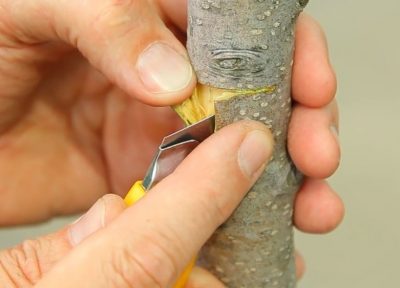

Cherries are one of the most commonly planted horticultural crops. Both the timing and the method of vaccination are important. According to the timing, it is customary to subdivide the vaccination into spring and summer.
Grafting belongs to the category of vegetative methods of plant propagation, which are based on combining parts of several garden crops. Reception is in demand when it is necessary to reproduce fruit or berry trees and shrubs.
The purpose of grafting
The peculiarity of combining the plants themselves or their parts is the ability to obtain the optimal combination of the qualities of the strongest and most resistant to weather conditions and diseases of the plant with high performance and quality characteristics of the harvest of another.
It should be remembered that the hybrid plants obtained as a result of grafting are not able to form fruits with similar quality indicators, and seed material will be produced exclusively on the upper part of such a plant.
The concept of scion and rootstock
The plant from which the stem part and root system are preserved is usually called the stock, or base.
The part of the plant, represented by the stem, leaves, or fruit, that is grafted onto the first plant, or rootstock, is the scion, or top.
The highest level of inoculation efficiency is observed with the same parameters of the stem part of the rootstock and the scion.
For optimal results, choose one of the following rootstock types:
- Forming rootstocks have lower rates of resistance to climatic conditions and damage by bacterial microflora, but are characterized by high rates of the formed yield.
- Vegetative rootstocks more resistant to weather changes, but have some disadvantages of fruiting. They are optimal for use in long and warm seasons.
To determine the most optimal variety for use as a grafted plant, all qualities of the rootstock should be evaluated.
The success of such a procedure as inoculation directly depends on the density of contact of plant tissues on the rootstock and scion, which are represented by the vascular cambium. It is for this reason that the material used should be properly and timely prepared and that the plant tissues are of high quality and suitable for inoculation.
- Cuttings of any fruit plants should be carried out in the autumn, closer to winter, but before the onset of sharply negative temperatures.
- Cuttings harvested from apple and pear can be stored in moistened sawdust on the bottom shelf of the refrigerator.
- Cuttings harvested from stone fruit are well preserved in a frozen state. Freezing should be carried out in frozen sawdust, after wrapping the cut cuttings with a damp cloth.
Choice of scion and rootstock
- The scion and rootstock cuttings should be dormant and have the same diameter, ranging from seven millimeters to one centimeter.
- The standard length of the cutting should be about thirty centimeters.
- The stalk must have at least three and no more than five buds.
Scion and rootstock preparation
- Remove the terminal end on the scion.
- Make a beveled cut at the base of the scion.
- Make a similar beveled cut on the rootstock.
- Cut out suitable tabs to secure the scion to the rootstock.
- Align the scion with the stock and fix it with a special grafting tape or other elastic material.
After four weeks, the wrapping should be removed from the grafting site so as not to restrict the growth of the wood.
Below the site of inoculation, all growths should be removed regularly.
Budding
The most popular and widespread method of vaccination. Budding can be carried out even by a novice gardener.
Stock preparation
- Cut an area at a quarter from the rootstock with an angle without removing the bark.
- Cut out a small area, aligning it with the corner cut until a notch is obtained and the bark is removed.
Scion preparation
- Cut a scion stalk with a bud in the central part according to the size of the cut rootstock section.
- Try on the scion on the rootstock, adjusting the size if necessary.
Direct vaccination
- Place the scion in the groove on the rootstock, making sure that there are no gaps and that the fit is as tight as possible.
- Fix the scion to the rootstock with any elastic material.
The best option is to use plastic wrap. When fixing, do not wrap the scion with the bud with foil. The retainer must be removed after four weeks.
If done successfully, the bud will start to grow, and next year it will be necessary to make an incision a centimeter above the awakened bud on the scion and remove any growth below the scion.
On the bark
Cuttings are harvested from healthy and productive plants, and the grafting itself must be carried out according to the established technology. The method is relevant if there is a stock that is too large for standard copulation.
What can you plant cherries on
Initially, you should grow or select a quality stock that is healthy, strong and young. The thickness of the stem can vary from three to ten centimeters. It is allowed to use viable and strongest branches with a diameter of at least ten centimeters. In addition, plant compatibility should be considered.
Cherry
Cherry grafting on cherries is the most optimal and common option. The most successful is the implementation of the spring grafting.Both regular cherry varieties and combinations with felt cherries can be used.
Sweet cherry
This combination is often successful which is due to the use of rootstock and scion from representatives of the same species. If the grafting is carried out correctly at the optimal time, the cuttings on the rootstock take root quite quickly. Any kind of sweet cherry is allowed.
Currant
An interesting way of grafting currants onto a cherry stock is widespread in Bulgaria. Here, the harvesting of cuttings is carried out in early spring with the subsequent preservation of the material under the snow or in the cellars. In the last decade of March, inoculation is carried out according to the method in the butt or in the cleft.
Bird cherry
A very popular option. Bird cherry in the middle zone of our country is widespread, is a very unpretentious and winter-hardy plant, which allows you to get the highest quality, frost-resistant and viable rootstock.
Cherry plum
Gardeners quite often use cherry plum as a material for grafting., which is due to the presence of a very strong and hardy root system in this fruit tree, which has a fairly high level of frost resistance. Of course, the reverse variant of vaccination is also allowed: cherry plum.
Cherry plum
Of the many stone fruits, it is the plum that is the strongest type of rootstock. The best option is to use semi-wild plums or thorns, which are easy to adapt to unfavorable climatic conditions and are resistant to most diseases.
An interesting option is grafting felt cherries onto thorns or plums. As a result, it is possible to get a stunted tree with a wide, spreading crown and many flowers resembling a blooming sakura.
We also recommend that you read the article on cherry hybrids.
Tips & Tricks
If the winter is too warm, it is possible to harvest cherry shoots for grafting. Cuttings are cut in mid-March and stored wrapped in a damp cloth on the bottom shelf of the refrigerator. The technique of grafting any stone fruit plants involves the use of an exceptionally clean and sharp budding or copulating knife.
All actions during the vaccination should be performed as quickly as possible. For fixing it is recommended to use a special grafting tape, which can be replaced with PVC or polyethylene film.
Can I keep 3 grafted cherry cuttings?
When grafting, two to 4 cuttings are placed on the branches of the stock, as in the photo.
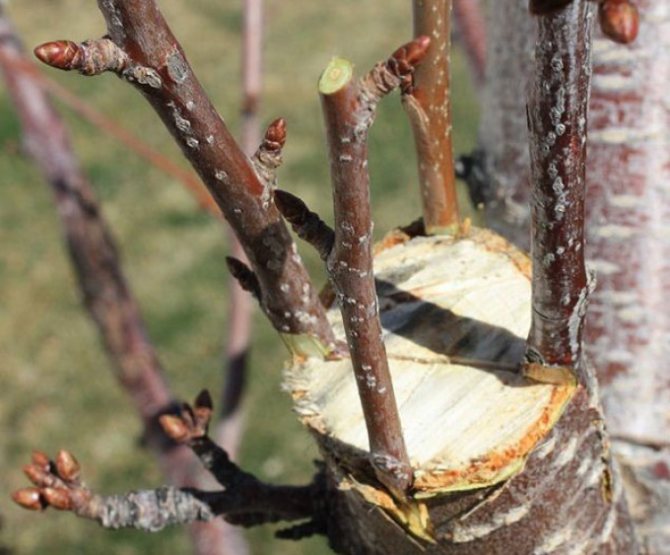

Grafted cuttings
This ensures uniform overgrowth of the saw cut. When the cuttings grow 15 cm, the weakest should be pinched. After 2-3 years, when the cuttings have taken root completely, they choose one - the most developed cutting. The rest are removed so that the overgrown branches do not interfere with each other.
In the next video, you can get acquainted and master the technique of grafting trees for the bark.
For the bark
A method that is best used when there is an abundant flow of juice. The branch to which the cuttings will be grafted is cut evenly, and incisions are made on the bark in several places.
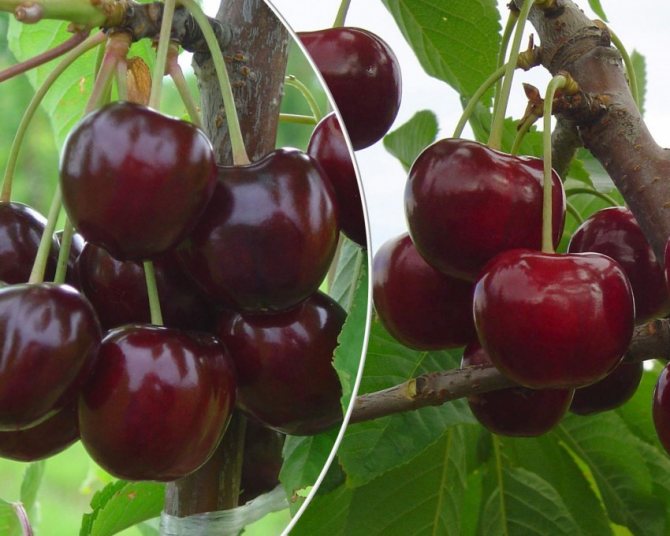

Cuttings are cut obliquely and cleaned from chipping. The graft is installed in the cuts. Over time, when the branches take root, only one strongest is left.
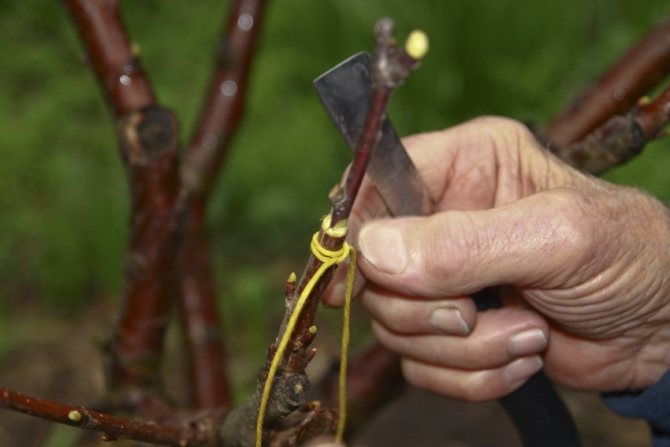

How to prepare cuttings?
For grafting, cuttings should be prepared in advance. Cuttings are harvested in the fall, before the onset of frost. Then they are stored all winter in appropriate conditions, and in the spring they are grafted.
Cutting length should be 35-40 cm, diameter 5 cm. These should be annual shoots with apical and lateral growth buds. The cuttings are tied into a bunch and stored either in the snow or in the basement in sawdust or sand.You can store the cuttings in the refrigerator, for this they are wrapped in a damp cloth, wrapped in a bag and sent to the lower shelf.
Grafting with fresh cuttings is also practiced, but they must be cut off before sap flow begins. The success of grafting with such cuttings is reduced.
What else depends on the success of the vaccination:
- All cuts on cuttings and rootstock must be clean. To do this, it is recommended to clean the rootstock slices and touch the slices with your fingers as little as possible.
- Hands and tools should also be clean.
- The knife must be very sharp. The cut should be done with one stroke of the knife. It is unacceptable to make irregularities, cracks, notches on the cuts.
- Vaccinations must be tied tightly, do not move the stalk after vaccination.
- The grafting procedure should be carried out quickly so that the sections are not ventilated.
- Open sections should be covered with garden varnish.
- Use only healthy and young trees as rootstock.
After 2-3 weeks, it will be possible to check if the cutting is taking root. Shoots from the buds appear on the engrafted cuttings. At this time, you should be especially careful about the tree:
- Check for pests. If they appear, take urgent action.
- Throughout the season, it is necessary to remove the shoots appearing on the rootstock below the grafted cutting.
- The grafted tree needs feeding, sufficient watering.
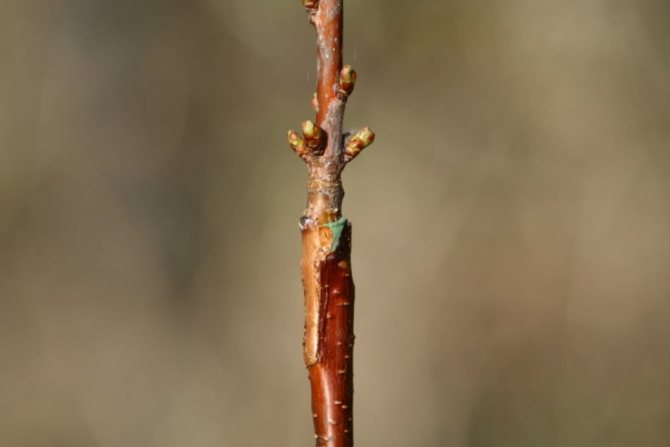

The result of successful engraftment of the cutting
Vaccination care
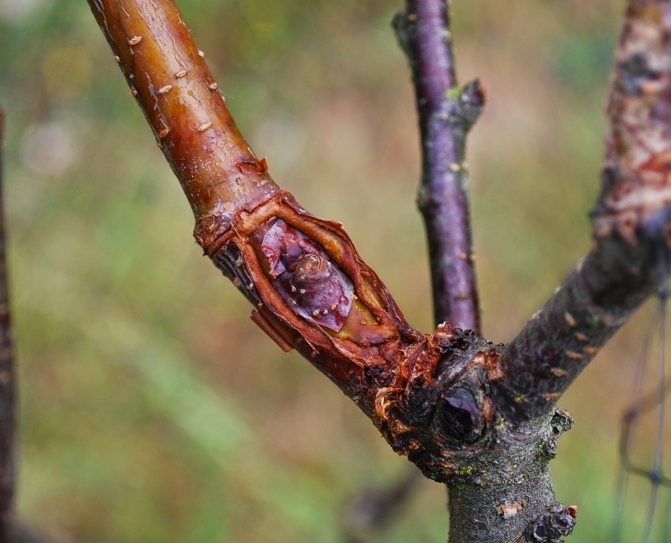

The grafted tree must be treated with an antiseptic, pinched and pruned
- Young leaves formed as a result of grafting often attract pests. Therefore, they must be sprayed regularly every 2-3 weeks. For this, Tanrecom or Biotlink preparations are suitable (3 ml per 10 l of water).
Important! Make sure that no shoots appear below the grafting site, otherwise they will take away all the food, and the cutting will not be able to develop.
- 1–2 months after the procedure, a splint is applied to each vaccination. This helps prevent damage from wind gusts or birds. For this purpose, you can use shoots of mountain ash or hazel. The tire should be sized to match the size of the inoculation. You need to tie it in two places on the scion and rootstock.
- In early August, the tops of the shoots that have grown on grafting are pinched. This is necessary in order to stop their growth and achieve better maturation. But if apical buds have appeared on the shoots, pinching is not carried out. After the foliage has fallen off, the tires must be removed from the grafts.
- The next year, with the onset of spring, the shoots are pruned. The height depends on the desired crown shape.
For example, if a gardener wants to get a tree in the form of a bowl or a bush, 40–70 cm should be retreated from the ground. If the goal is a tiered crown, pruning is performed at a distance of 80–120 cm from the ground.
- When horizontal branches are formed on the graft, they are pinched at a level of 50 cm from the base.
- In the third year, all annual shoots are shortened to 50 cm. If their length is less than this size, pruning is not performed. Branches growing inside the crown, as well as those that have sharp corners, are removed.
Grafting cherries on plums: advantages and disadvantages
Grafting cherries on plums is not the best option. The accretion of cherry and plum wood occurs with great difficulty, most often the result of the experiment is unsuccessful. As a result, you can waste your time and energy and get nothing in return.
However, experienced gardeners manage to plant cherries on plums. In the case of a successful experiment, a "miracle tree" is obtained, on which different fruits grow. This can save your garden space, which is usually limited to a few acres.
Grafting of cherries on plums is carried out in most cases when there is nothing else to graft on. Try it, maybe you will succeed.
Cherry grafting is an interesting experiment, the success of which depends on many factors.Cherry grafting should be taken seriously, it is very important to comply with all the requirements for the instrument, the timing of the grafting, the cleanliness of the cuts and the care of the tree after grafting. Then the result of your work will be able to bear fruit in the truest sense of the word.
Conditions for vaccination
In order for the stalk to take root in the stock, certain grafting conditions must be observed:
- Choose the optimal time of the year for the grafting process.
- Choose the right plant on which the scion will be planted, as well as prepare the cuttings themselves.
- Prepare and disinfect the instruments that will be used for grafting cherries.
- Carry out the process of grafting the tree, observing the order of each stage and safety rules.
- Properly organize the care of the grafted plant.
The timing of the vaccination
The most successful seasonal phases of cherry grafting are:
- spring periods, starting from March and ending with the first decade of April;
- summer - from the second decade of July to August.
However, based on horticultural experience, it is spring, at the peak of sap flow in trees, that is represented by the best period for grafting.
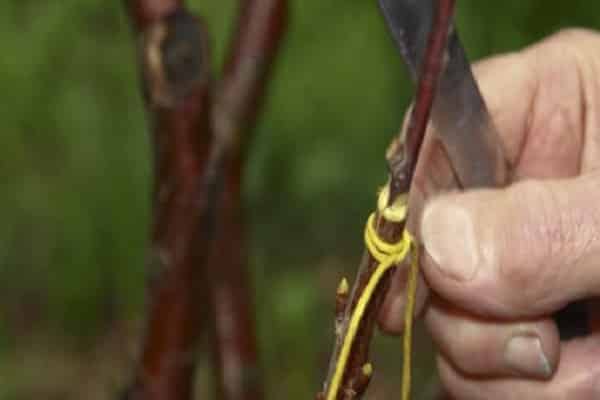

Summer, for grafting cherries with green cuttings, even at the moment when branches stop growing, is not the best period of time, due to the mismatch between the rootstock and the scion of the cambial layers.
In relatively warm weather, crossing can be carried out in the fall, but, in any case, the period of fusion will be fully completed only closer to spring.
In winter, fruit trees, with a slowdown in metabolic processes, are in the so-called hibernation.
Important! If the grafting technology will be carried out in summertime conditions, watering of the stock must be carried out ahead of time, in order to accelerate the sap flow.
See also
Description and characteristics of the Zagorievskaya cherry variety, planting, cultivation and careRead
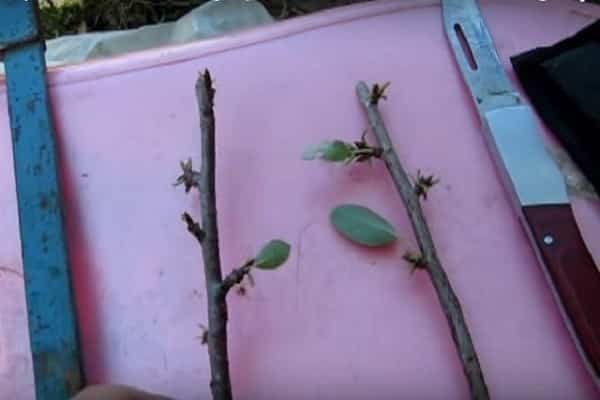

Lack of personal experience
The cultivation of cherry plantations on dwarf rootstocks has not yet acquired an industrial character in Russia. Accordingly, we have no experience in cultivating such gardens, and there are only a few gardeners who have begun to grow cherries using intensive technology on dwarf rootstocks. There are such only in the Krasnodar Territory and in the Crimea.
In scientific institutions of Russia, the principles for the use of a wide range of well-known medium-sized and dwarf rootstocks are not laid down. For this reason, the assessment (for Russian conditions) of the types of rootstocks for sweet cherry by scientists has not yet been properly covered in the special literature.
For gardeners who decided to intensify the production of cherries and plant a garden with a density of up to 3 thousand pieces. seedlings per hectare, you have to use the experience and best practices of Dutch, Italian, German, Polish and other gardeners. The use of foreign technologies by our gardeners for intensive apple orchards with M9 rootstock confirms the correctness of these actions.

